Deep, nature-inspired paint has surged to the forefront of exterior design over the past two years, and dark green exteriors are leading that shift. Trend analyses for 2025 show homeowners gravitating toward verdant façades because they complement almost every architecture, hide pollen and dust better than paler colors, and visually blend buildings into the surrounding landscape for a calmer street presence. Designers also point to the psychological pull of green, noting its links to balance, renewal, and environmental stewardship—qualities increasingly prized in sustainable architecture. Below you’ll find twenty practical, style-forward ideas that translate those broad benefits into specific, actionable upgrades for any home.
1. Dark Green Exterior with Natural Wood Accents

A well-timed mix of rough-sawn cedar and a dark green exterior creates instant warmth while keeping the palette firmly rooted in nature. The color saturates the walls and lets the wood’s honey undertones pop around soffits, porch beams, or a feature gable, producing the same indoor-outdoor continuity that upscale mountain homes chase with costly reclaimed timbers. Designers suggest applying a clear, matte sealer to the cedar so it silvers gracefully without competing against the paint, keeping maintenance low yet character high. Because both materials come from long-lasting FSC-certified sources, the pairing also satisfies today’s growing demand for visible sustainability on the street.
2. Dark Green Exterior with Jet-Black Trim
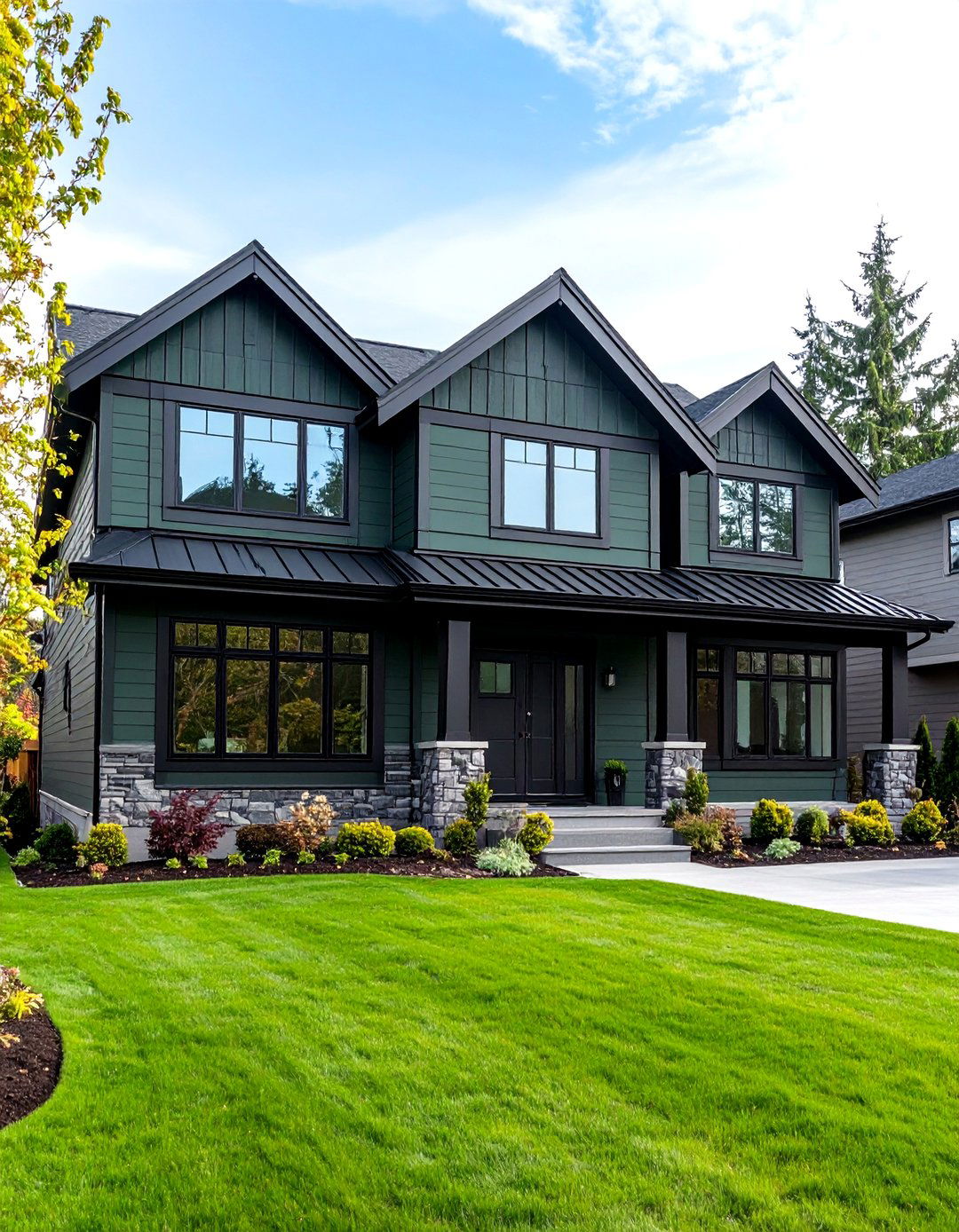
By pairing a dark green exterior with razor-thin black window trim and gutters, homeowners achieve a modern edge without straying from an earth-friendly palette. The black framing sharpens architectural lines, so eaves and mullions read crisper against the moody backdrop, a combination renovation blogs identify as one of the season’s most reposted façade details. Because both hues sit low on the light-reflectance scale, the scheme suppresses glare, allowing accent lighting and landscaping textures to star after dusk. Paint contractors note that using the same sheen—typically a satin exterior enamel—on both colors keeps the look cohesive and hides pollen better than higher-gloss whites.
3. Board-and-Batten Dark Green Exterior for Modern Farmhouses

This modern farmhouse interpretation keeps its rural soul yet feels contemporary by cloaking crisp board-and-batten siding in a saturated dark green exterior. Vertical planks stretch the walls visually, so even single-story profiles gain stature, while the deep hue grounds the home against sweeping prairie views. Designers often follow with oversized matte-black sconces and galvanized planter boxes to echo barn heritage without defaulting to cliché red. If you’re budgeting, choose an acrylic stain instead of full paint; it penetrates the wood, so chips expose similarly toned fibers rather than raw pine, reducing touch-ups across freeze-thaw seasons—an advantage that helps farmhouses age gracefully in harsh climates.
4. Deep Forest-Green Exterior for a Victorian Revival
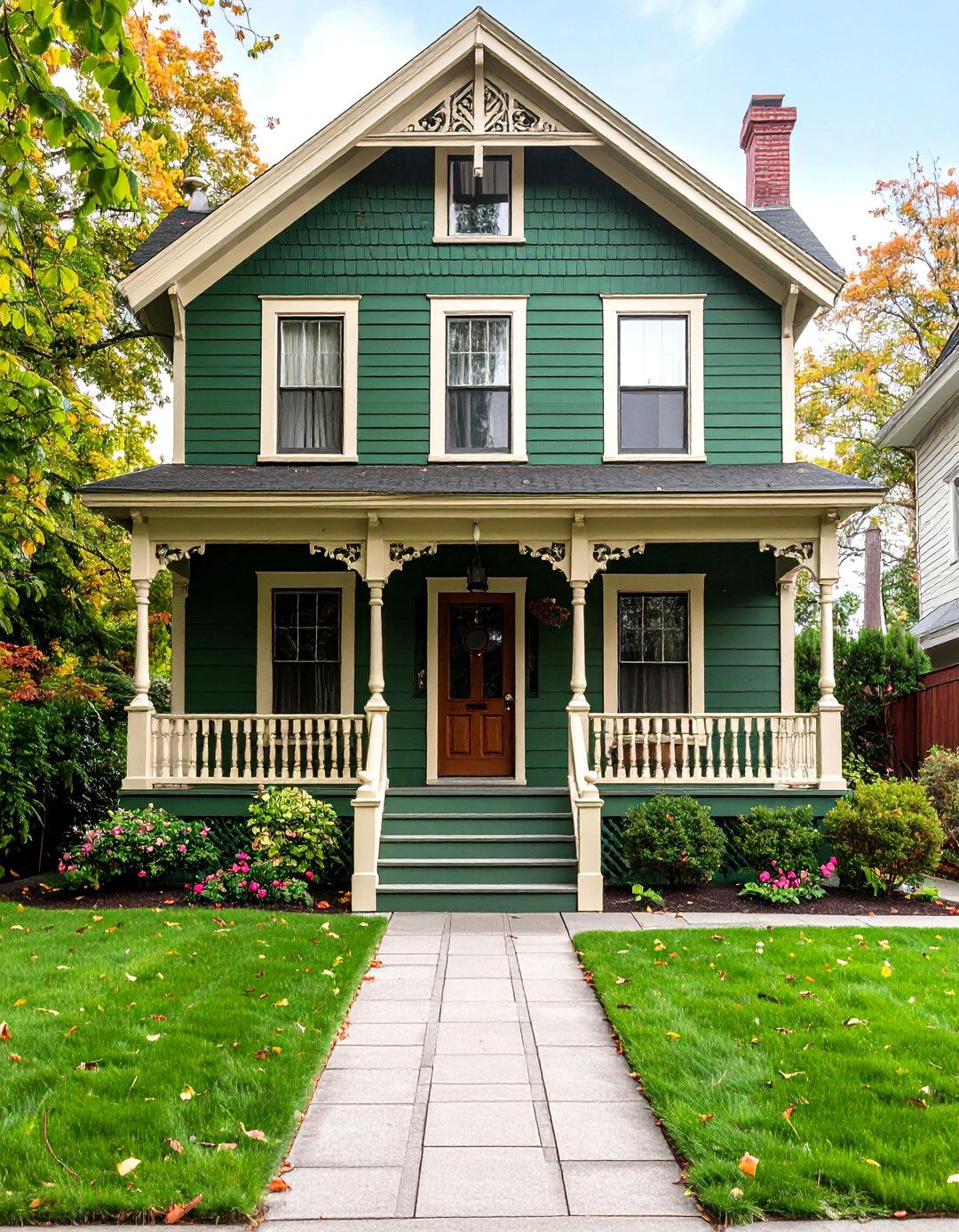
Take a Queen Anne or Folk Victorian and drench the clapboard in deep forest green, then pick out spindlework in slightly lighter olive for period-correct depth. Trend monitors rank this approach among the top nostalgic color comebacks of 2025 because it respects original craftsmanship while toning down the carnival palettes that sometimes scare buyers. The muted dark green exterior allows ornate brackets and fish-scale shingles to read as texture rather than competition, letting the architecture, not the paint, provide movement. Preserve authenticity by using mineral-based paints, which now come in breathable, low-VOC formulas that protect century-old wood.
5. Two-Tone Dark Green Exterior with Earth-Brown Panels

Consider blending a saturated dark green exterior on upper stories with warm brown paneling or stone at ground level for an earthy, biophilic stack. Color-trend roundups note that green-and-brown pairings have surged because they mimic mountainside strata and help large façades feel less monolithic. The darker top visually lowers the roofline, while the brown base hides splashes from rain or sprinklers, trimming yearly maintenance. Where codes restrict full wood siding, installers achieve a similar effect using fiber-cement panels factory-finished in chestnut hues, meeting fire benchmarks without sacrificing the layered aesthetic.
6. Dark Green Exterior with Crisp White Accents
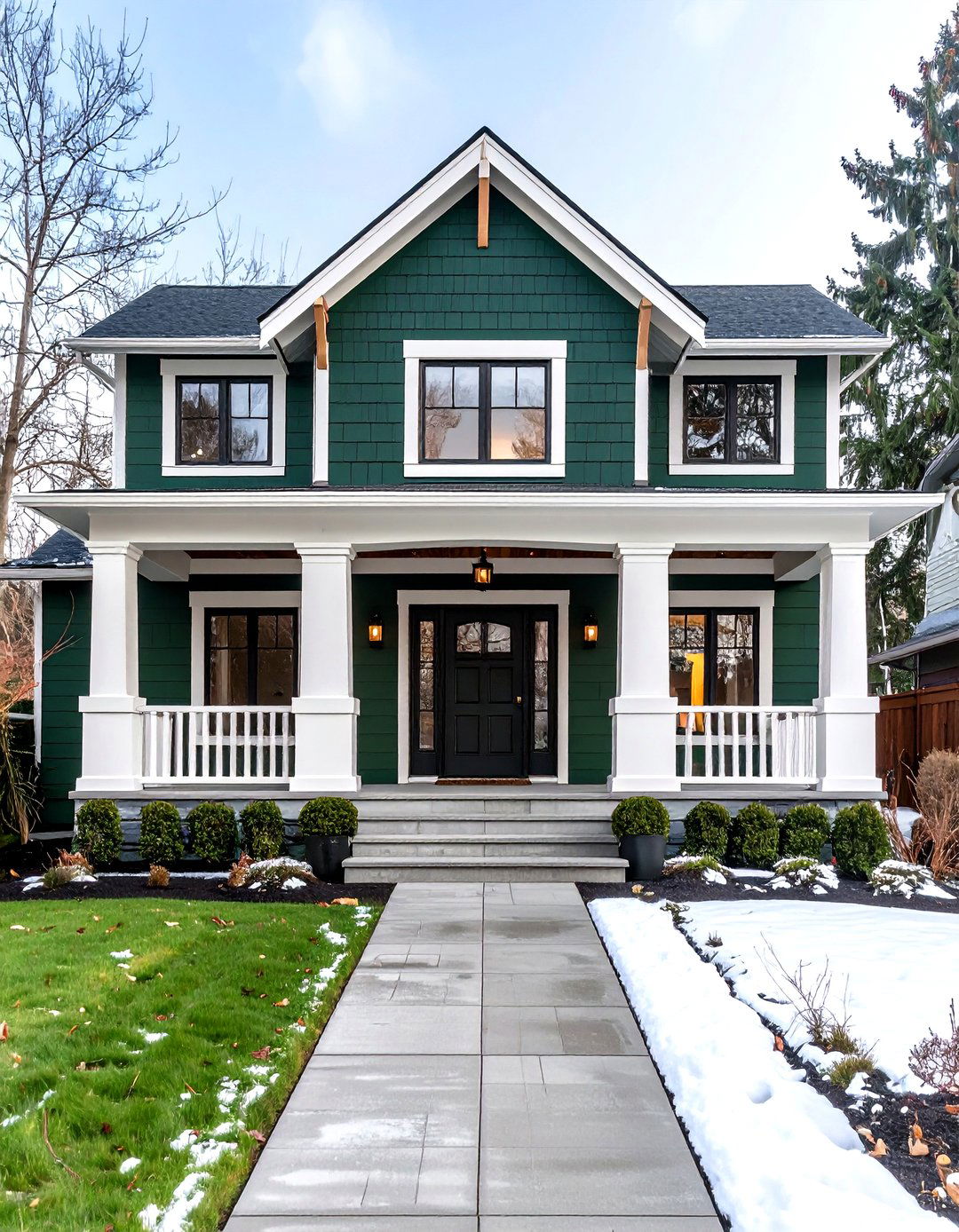
Looking for unmistakable contrast? A rich dark green exterior framed by icy white trim around windows, rake boards, and columns delivers instant definition across every architectural style. The high-value light-reflectance difference brightens shadowed corners, especially on north-facing façades that rarely see direct sun. Maintenance is simpler than many assume: latex exterior whites now contain dirt-shedding additives, and the darker body colour hides inevitable specks between annual washes. For added nuance, swap bright white for a soft greige on railings; neutral undertones temper the transition and tie interior palettes to the outdoors without veering into farmhouse clichés.
7. Dark Green Stucco for a Modern Mediterranean Twist
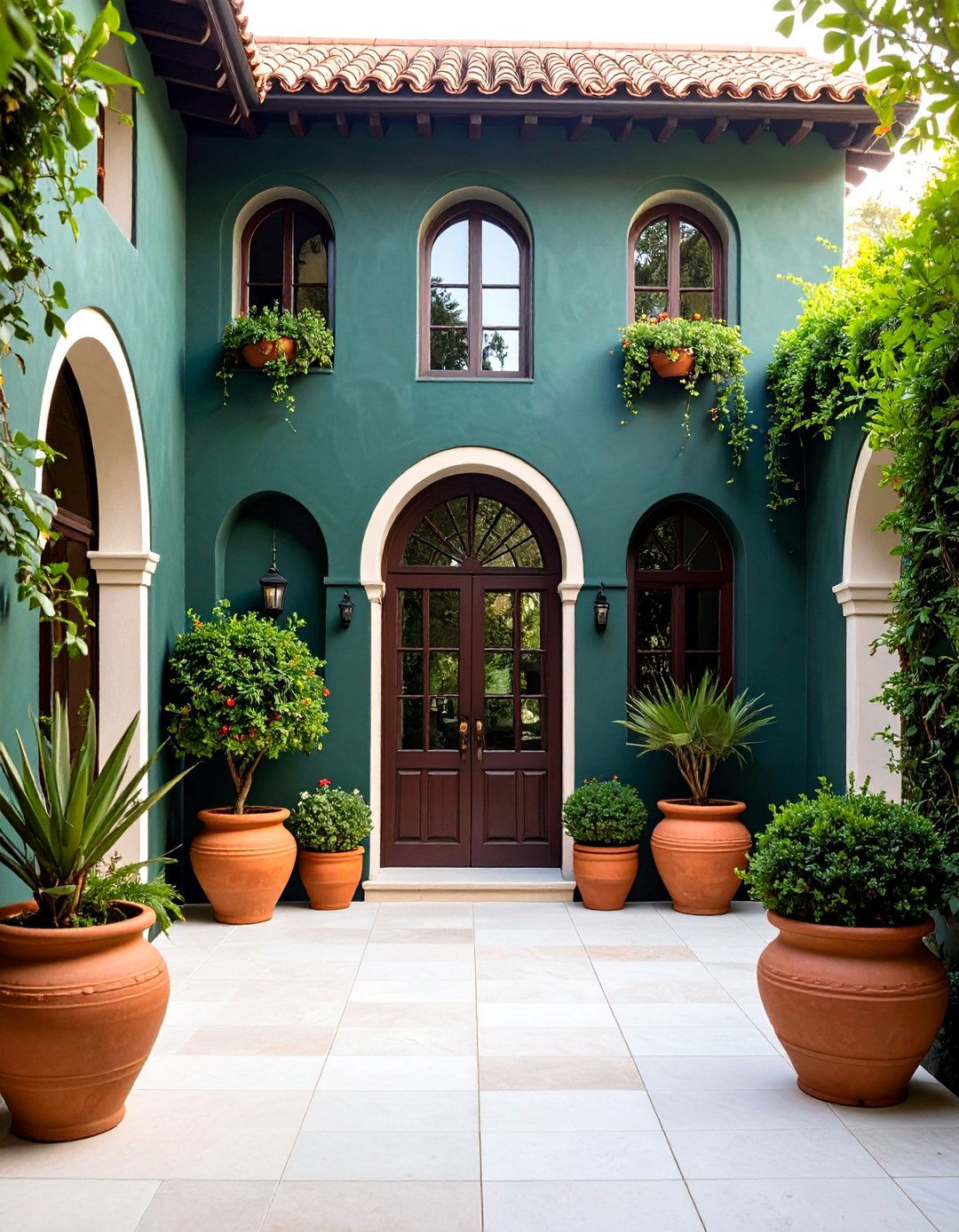
One Mediterranean twist coats smooth stucco in a saturated dark green exterior rather than the traditional sandy beige, instantly modernizing arches and clay tiles. Architects highlight green’s calming psychology—its associations with balance and renewal—making it ideal for indoor-outdoor living that defines Mediterranean layouts. The color also minimizes glare off sun-baked courtyard walls, creating cooler visual temperatures even as ambient heat rises. To keep the look cohesive, specify bronze door hardware and warm-toned terracotta pots; both metals complement the hue’s earthy undertone, preventing the scheme from veering nautical. Seal the stucco with breathable silicate coatings to resist coastal salt spray without trapping moisture.
8. Dark Green Exterior with Patinated Copper Roofing
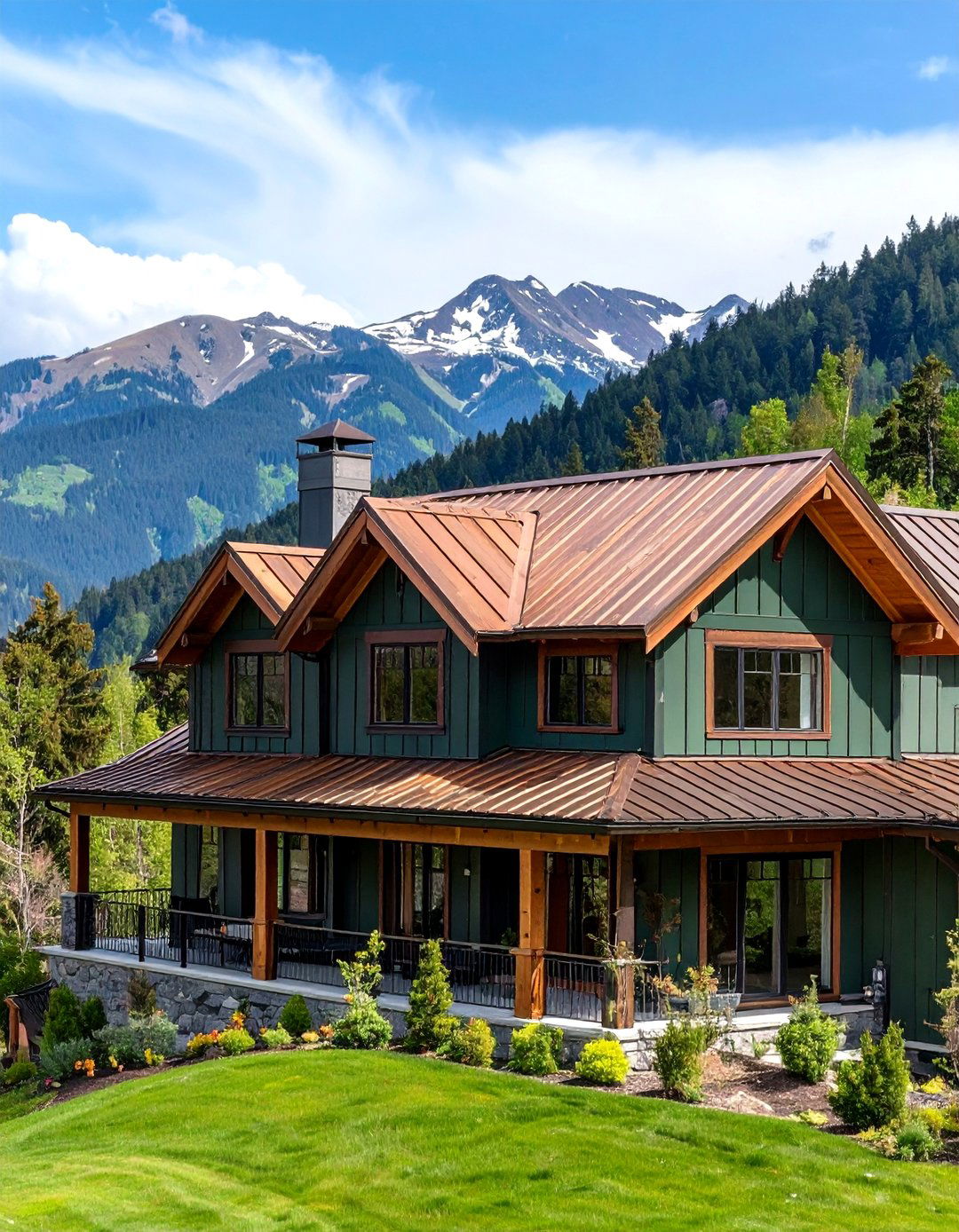
Unlike lighter shades, a dark green exterior gains further depth when topped with real or faux copper that oxidizes to a soft verdigris over time. Building-envelope experts say copper lasts decades, and its warm undertone echoes green’s yellow component, forging harmony as it ages. Homeowners in snowy zones appreciate copper’s smooth surface, which sheds ice faster than asphalt, protecting gutters. If budget is tight, install a copper standing-seam accent over the porch rather than the full roof; the focused flash still elevates perceived value. Pair with slimline solar panels in matte black so technology recedes, letting the evolving metal finish do the talking.
9. Dark Green Exterior with Shou Sugi Ban Accents
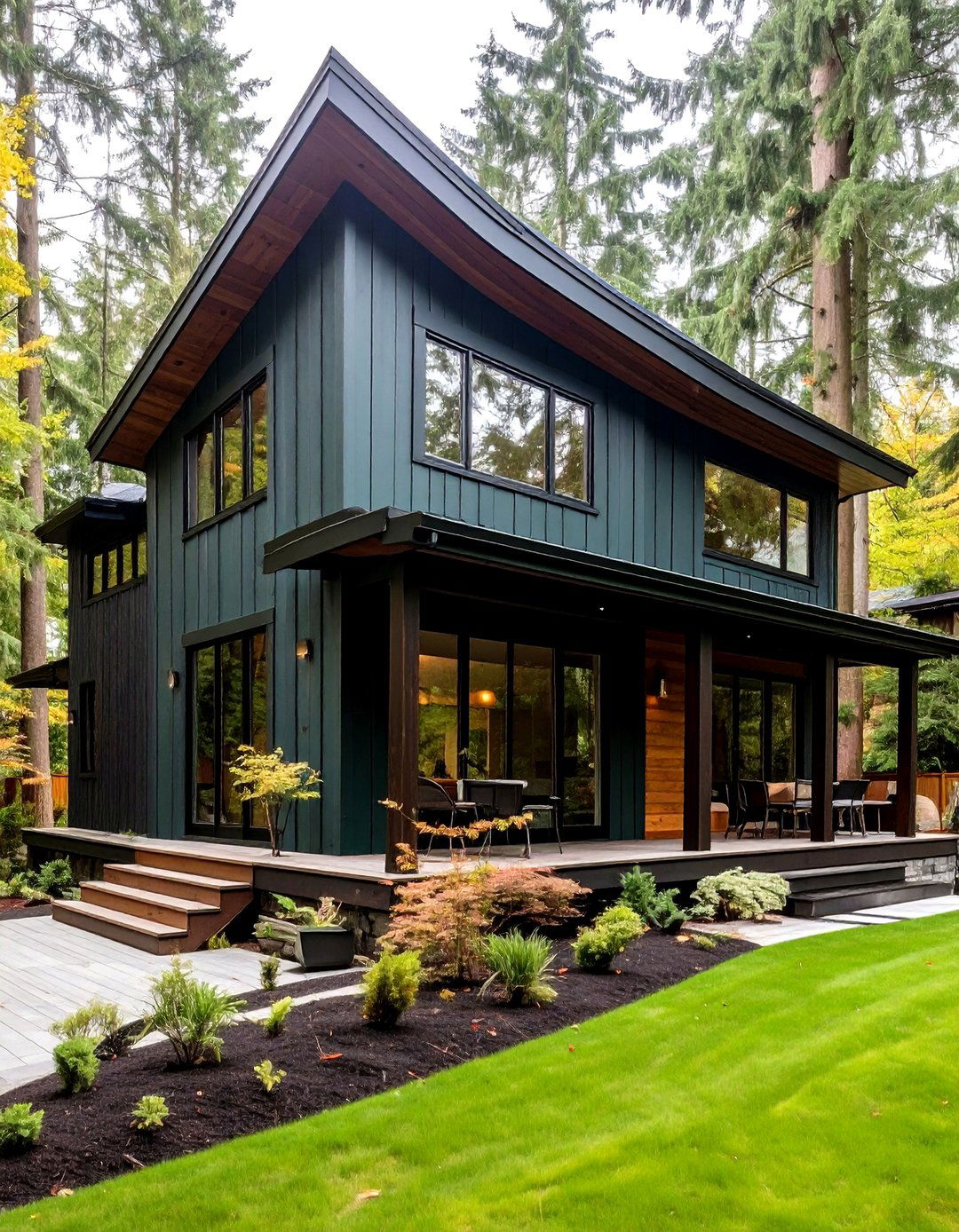
Despite its ancient roots, shou sugi ban charred wood siding now appears on cutting-edge builds, and it partners effortlessly with a dark green exterior. The carbonized planks read as near-black but retain tactile grain, offering tonal variation without disrupting the calming green field. Charred surfaces are naturally rot-resistant, reducing the need for chemical preservatives—a sustainability win that complements green’s eco symbolism. Place the charred boards in recessed porch ceilings, garage doors, or vertical stripes between windows to create rhythmic shadows. Because both finishes are low-sheen, they hide dust and pollen, ideal for wooded lots where regular hose-downs replace full-scale power washing.
10. Mixed-Material Dark Green Exterior with Batten and Brick
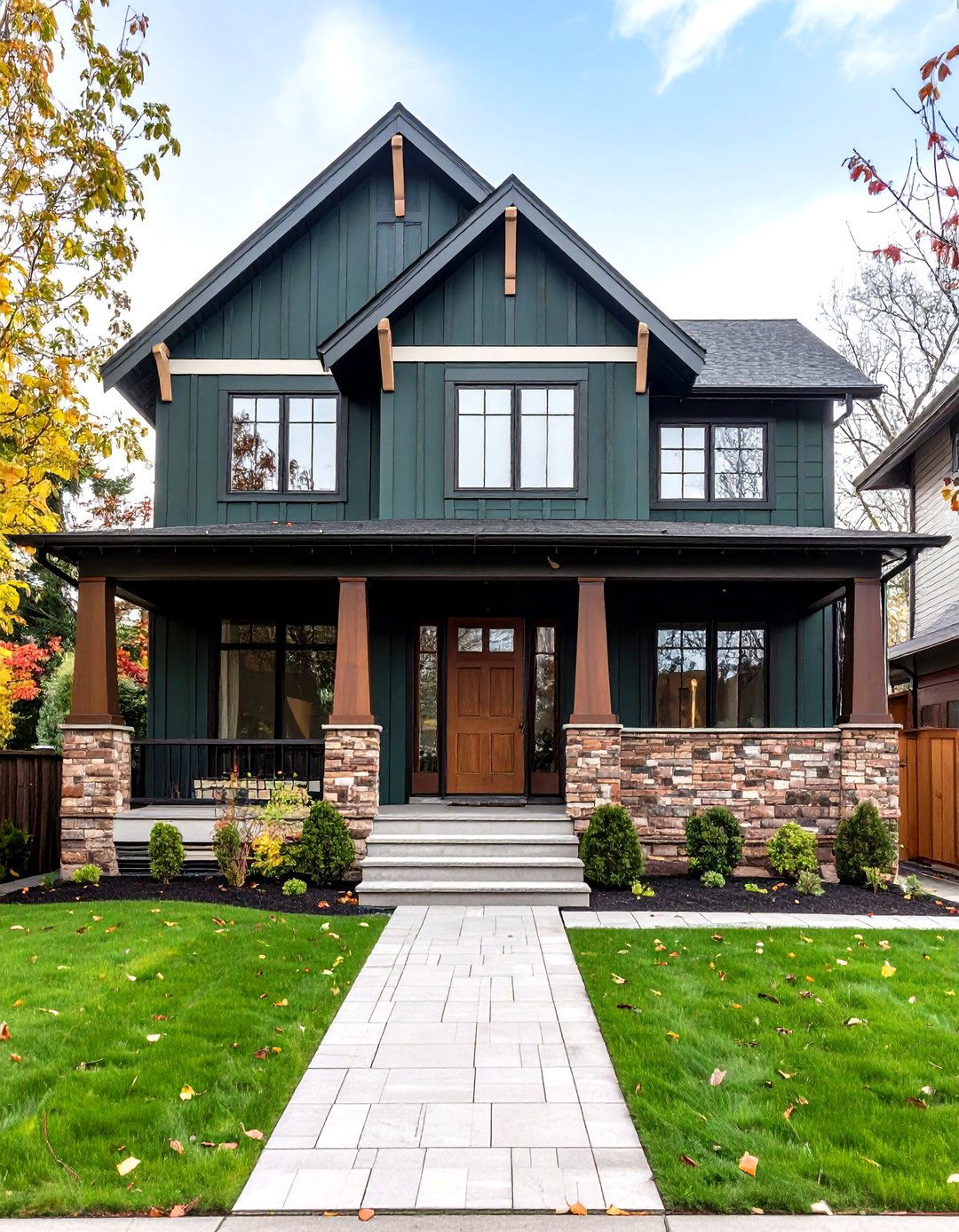
With mixed-material façades trending in new-build renderings, combining a dark green exterior on upper stories with warm brick at the base introduces textural layering without an eclectic jumble. Brick’s matte surface diffuses light, so the green above feels even richer by contrast, while the masonry protects areas most susceptible to hose splashes or snow buildup. Designers recommend elongated bricks in muted taupe or cocoa tones rather than high-contrast reds; subtlety keeps the house from reading holiday-themed. Complete the palette with sand-coloured mortar and brushed-nickel house numbers for a sophisticated yet welcoming street stance that appeals to broad buyer demographics.
11. Dark Green Exterior Anchored by Natural Stone
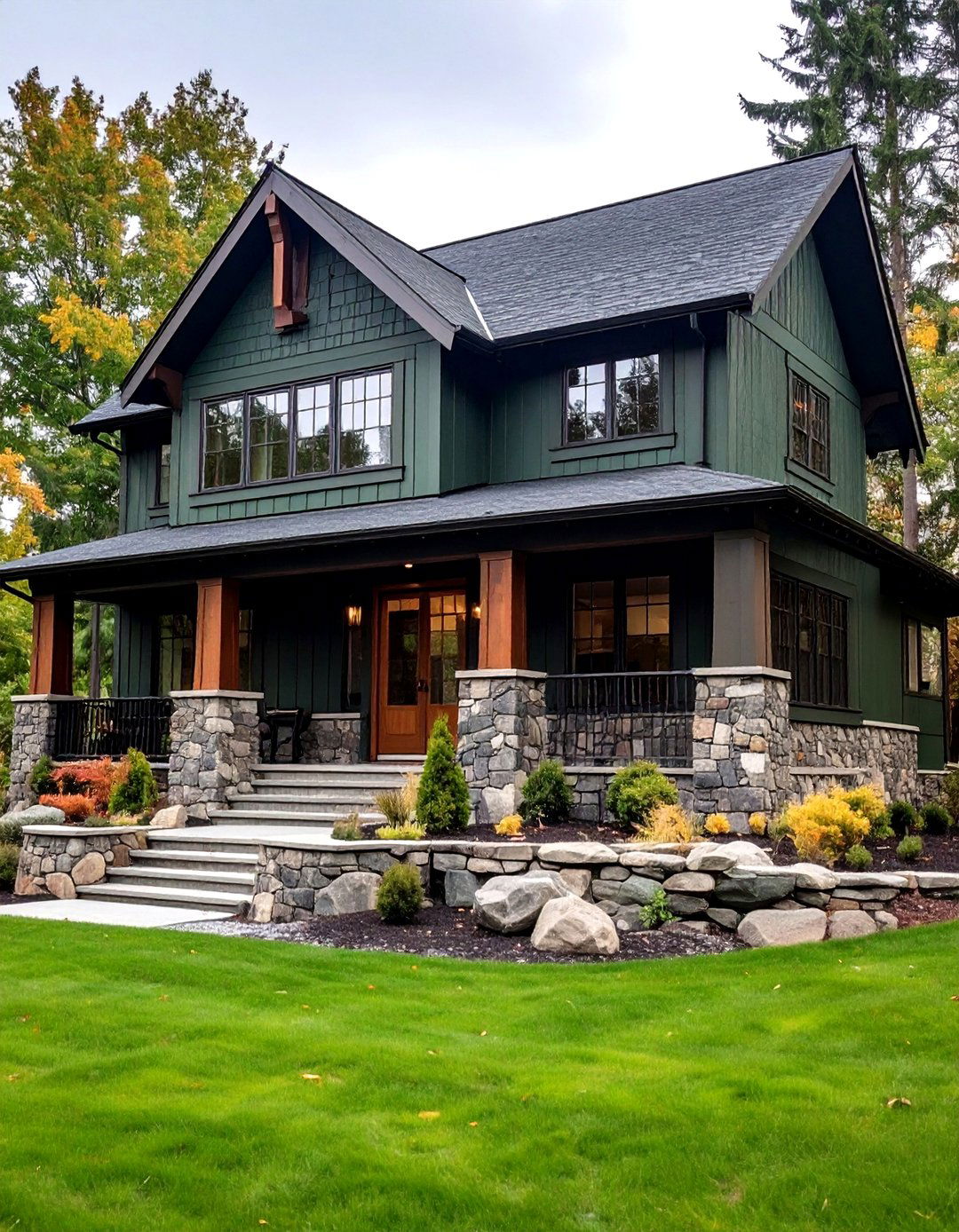
Studies into curb appeal show that a dark green exterior gains instant gravitas when anchored by chunky limestone or fieldstone around foundations, porch piers, or chimneys. The stone’s neutral grays and tans temper saturation, preventing the colour from feeling heavy on large footprints. In fire-prone regions, installing stone veneer panels two feet up the wall creates a non-combustible barrier that doubles as a stylish wainscot. Choose irregular, dry-stack profiles to echo forest boulders, then continue the stone along landscape walls so the house tumbles organically into the yard—a strategy landscape architects praise for dissolving hard property lines.
12. Energy-Smart Dark Green Exterior for Colder Climates

When energy bills climb, a dark green exterior can help warm houses passively because darker pigments absorb more solar energy than light tones, trapping up to 90 percent of the sun’s heat according to building-science blogs. Painters in northern markets report measurable reductions in furnace run times after clients switched from beige to deep green siding. To maximize gains, specify insulated siding panels or add a continuous rigid-foam layer under lap boards, then finish with low-VOC paints that include ceramic microspheres for extra thermal resistance. The strategy pays dividends during shoulder seasons when passive warming can fully replace mechanical heating on sunny days.
13. Dark Green Exterior for Compact Cabins and Tiny Homes

As tiny homes multiply on wooded lots, a dark green exterior has become a go-to strategy for making small footprints feel intentional rather than temporary. The color lets metal roofs and solar panels become subtle instead of techy, helping these movable structures slip under tree canopies with minimal visual disturbance. Opting for corrugated steel siding powder-coated in forest green further trims weight compared with wood, a crucial factor when towing remodel-ready ADUs. Because green psychologically signals tranquility, interior square footage can be modest without sparking claustrophobia, a bonus for downsizers seeking calm, minimalist living.
14. Dark Green Exterior with Black-Framed Windows for Urban Townhouses
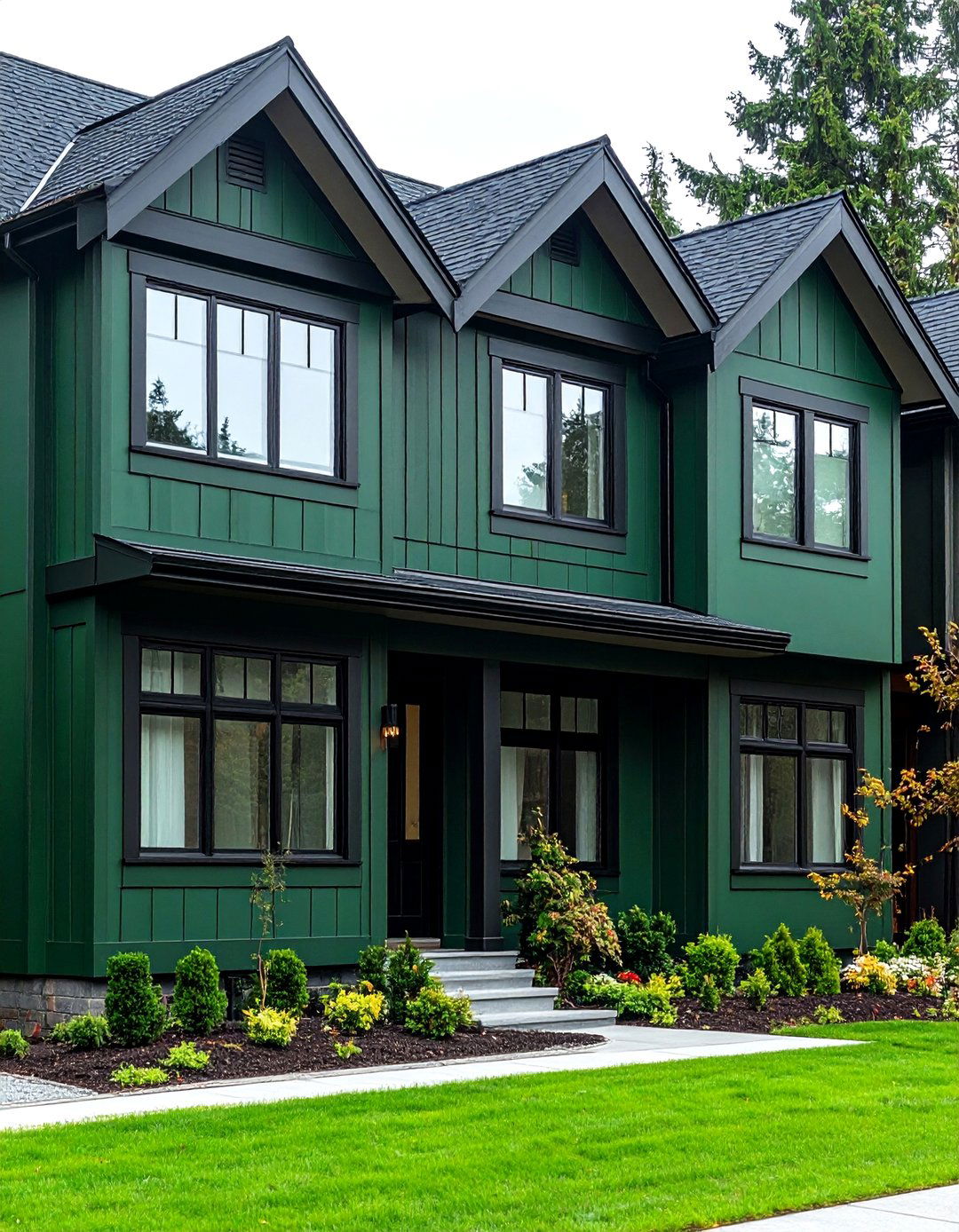
Certainly, urban infill townhouses benefit from bold yet refined palettes, and a dark green exterior accented by slim black window frames satisfies both modern tastes and historic district guidelines in many cities. The combination sharpens facade rhythm, visually stretching narrow elevations without resorting to bright, contentious colors. Renovators observe that dark body colours also mask inevitable soot from nearby traffic better than pastel paint, reducing facade cleaning cycles. To prevent heat buildup, install low-emissivity glazing; it blocks solar gain through those fashionable oversized panes while still allowing the dark palette outside. Rain-screen cladding behind the siding provides airflow, preventing moisture trapping in humid metro climates.
15. Dark Green Exterior with Light Sand-Tone Trim for Coastal Homes
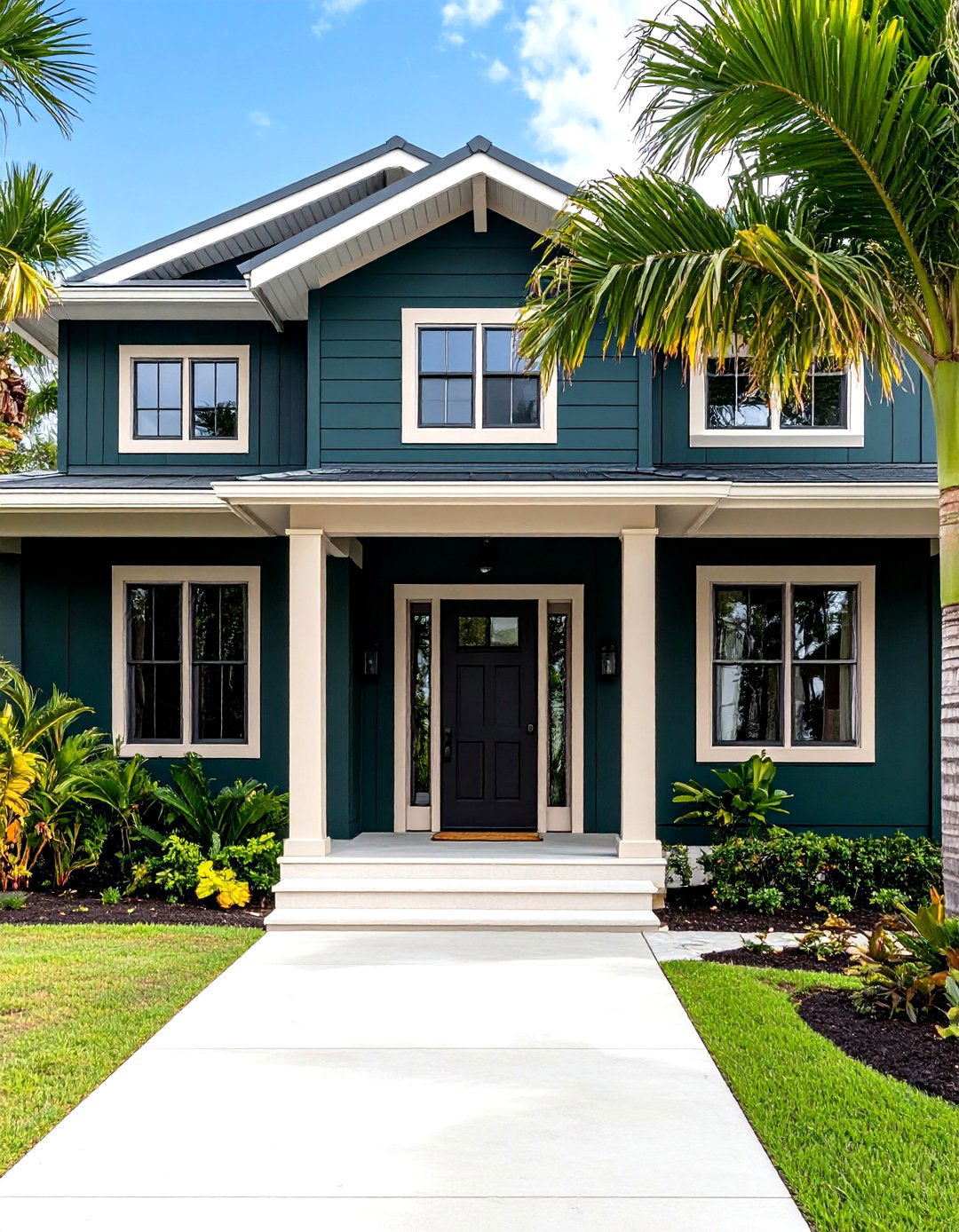
Meanwhile, coastal properties increasingly turn to a dark green exterior trimmed in soft sand or driftwood tones to echo nearby dunes without defaulting to nautical navy. Color trend forecasters note the scheme sells because it blurs the boundary between man-made shelter and native scrub, preserving view corridors for neighbors. Use salt-resistant acrylic paints with elastomeric additives; they flex over hairline cracks that appear when sea-air moisture expands and contracts clapboard. Pair with matte stainless hardware that withstands corrosion yet visually recedes, allowing tropical landscaping—palms, cordylines, beach daisies—to supply vibrant accents free from the paint budget.
16. Dark Green Exterior Integrated with Living Roofs
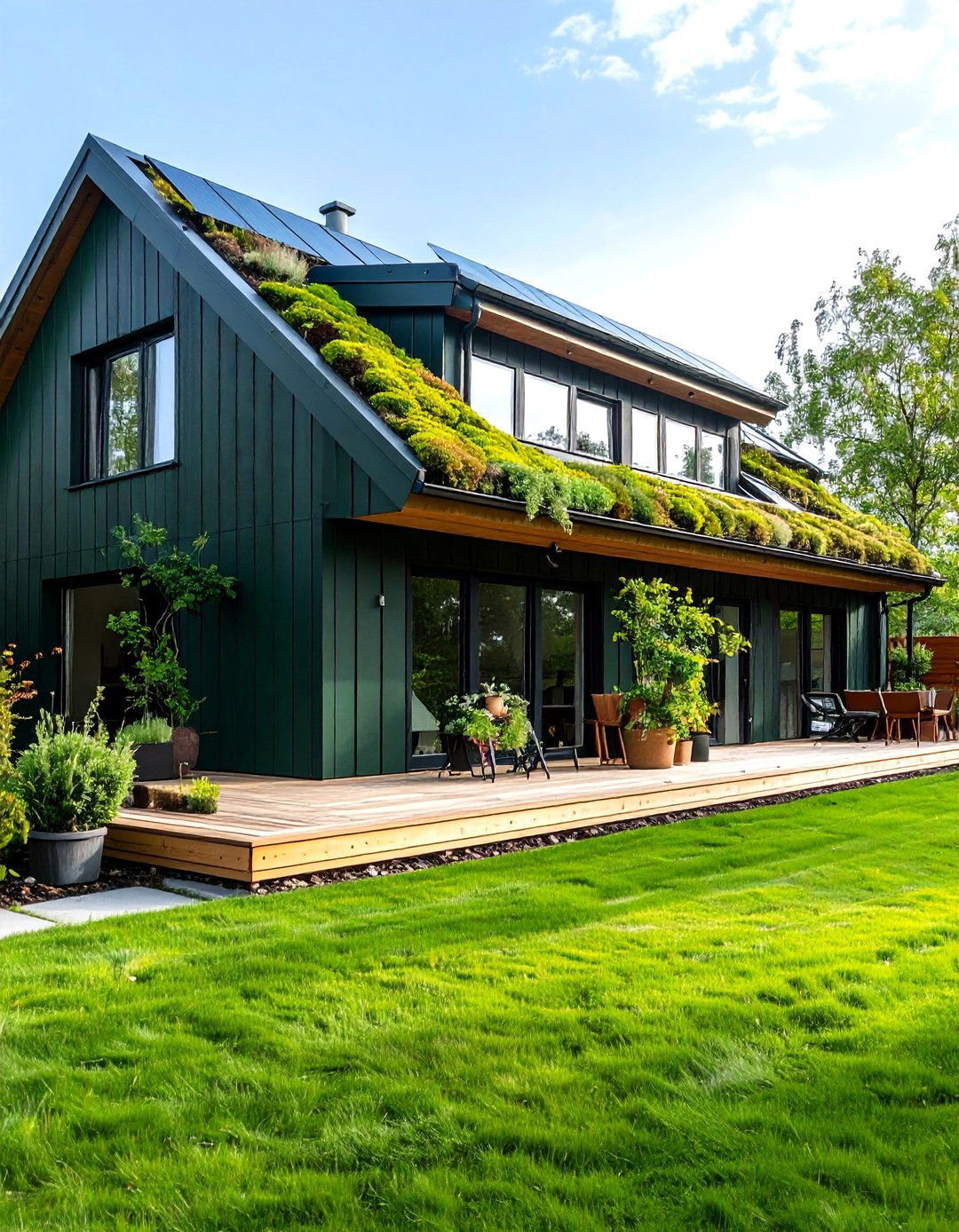
Bringing living roofs into the conversation elevates sustainability and spectacle: sedum-planted membranes above a dark green exterior extend the color story upward, creating a seamless vertical-to-horizontal green plane. Horticulturists find that residents perceive planted roofs as an extra yard, enhancing biophilic connection without consuming ground area. The low-height foliage keeps roof temperatures cooler than black membranes, offsetting the heat absorbed by the darker walls. Specify drainage mats rated for regional rainfall and choose silver flashing instead of stark white to maintain the muted aesthetic. LED uplighting from soffits can softly spotlight the living roof at night, highlighting textures without glare.
17. Horizontal-Clad Mid-Century Dark Green Exterior
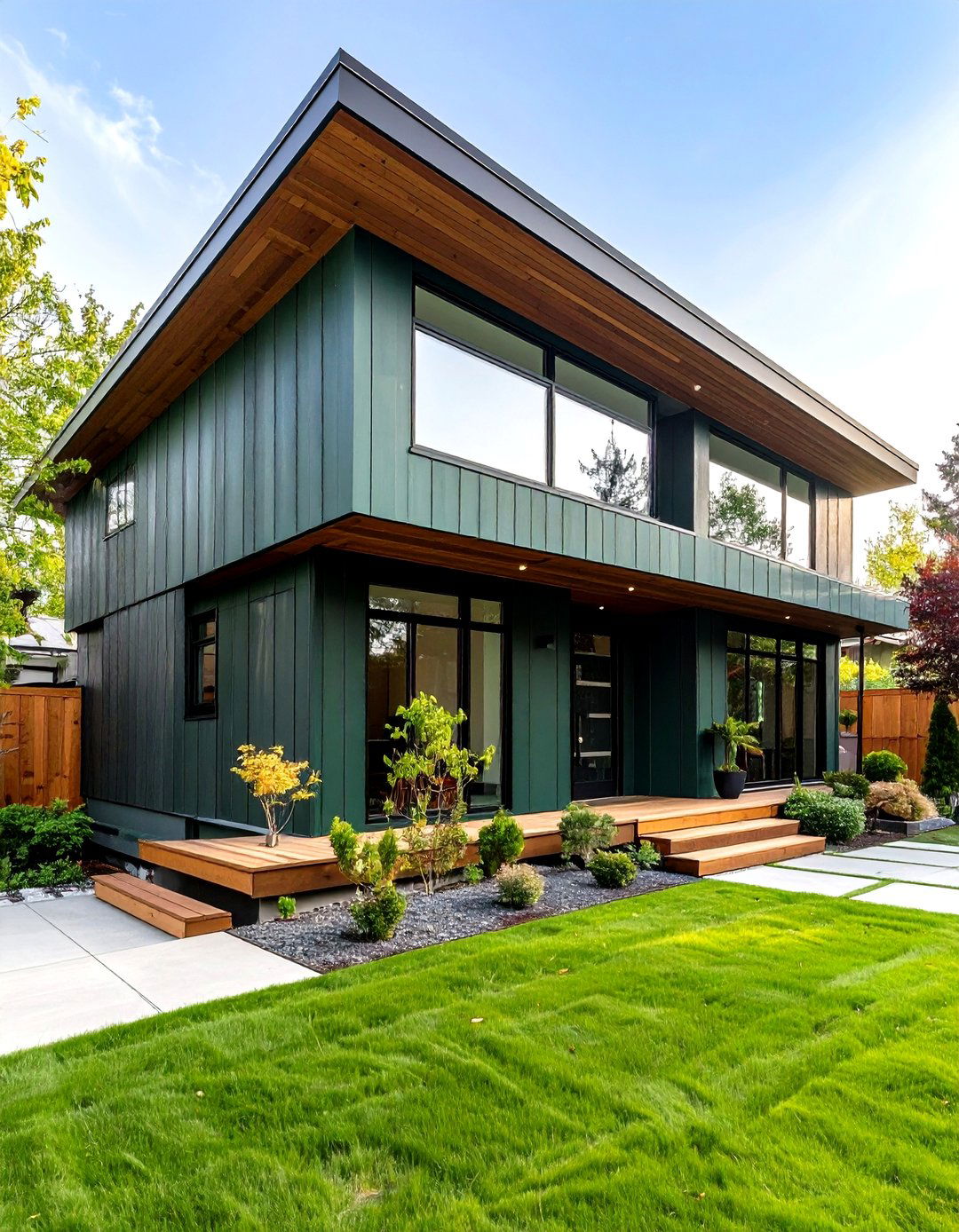
Additionally, a mid-century modern outline with broad eaves and ribbon windows thrives when dressed in a horizontal cedar or fiber-cement cladding finished in a stately dark green exterior. The long, uninterrupted boards emphasize the era’s obsession with linearity, while the color pushes the house deeper into its lot, an optical trick that restores privacy in now-dense suburbs. Accent the look with slim stainless steel house numbers and an orange-stained front door—mid-century’s signature complementary pop. Keep soffit undersides natural pine to reference period tongue-and-groove ceilings, subtly dialoguing interior and exterior materials without raising maintenance budgets.
18. Camouflaged Forest Cabin with Dark Green Exterior
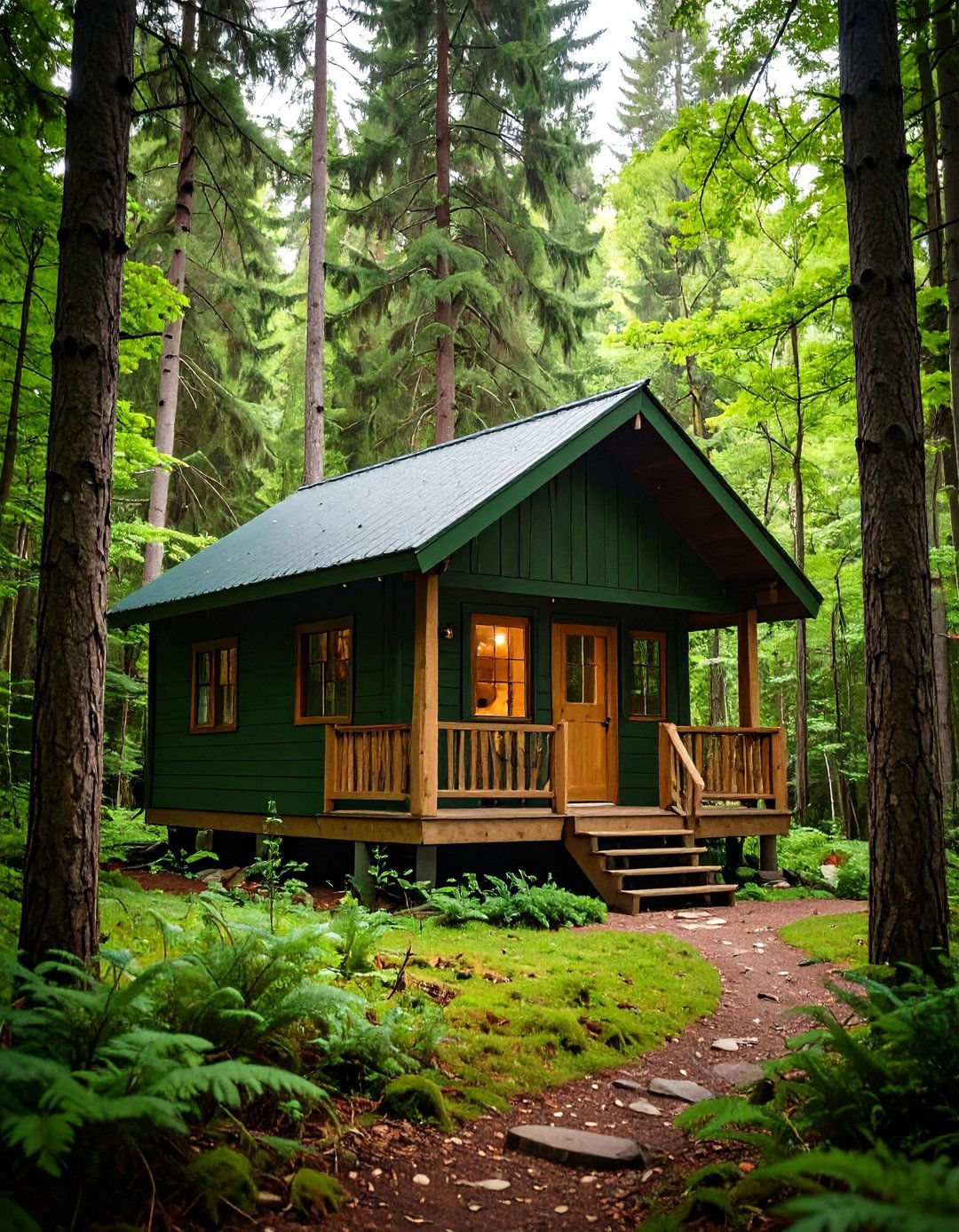
Although forest cabins already nestle among trees, coating them in a dark green exterior camouflages reflective surfaces, helping wildlife approach undisturbed—a feature eco-tourism operators bank on for authentic nature encounters. To avoid creating a monotonous block, break planes with lighter semi-transparent stains on deck rails and incorporate glass corner walls that mirror foliage. Energy-efficient stoves replace heavy HVAC, but the dark siding still passively boosts interior warmth on clear winter days. Use fire-resistant composite decking in similar tones to reduce ember risk in wildfire-prone forests while keeping the palette cohesive from ground to rafters.
19. Subtle Dark Green Exterior for Garages and Outbuildings
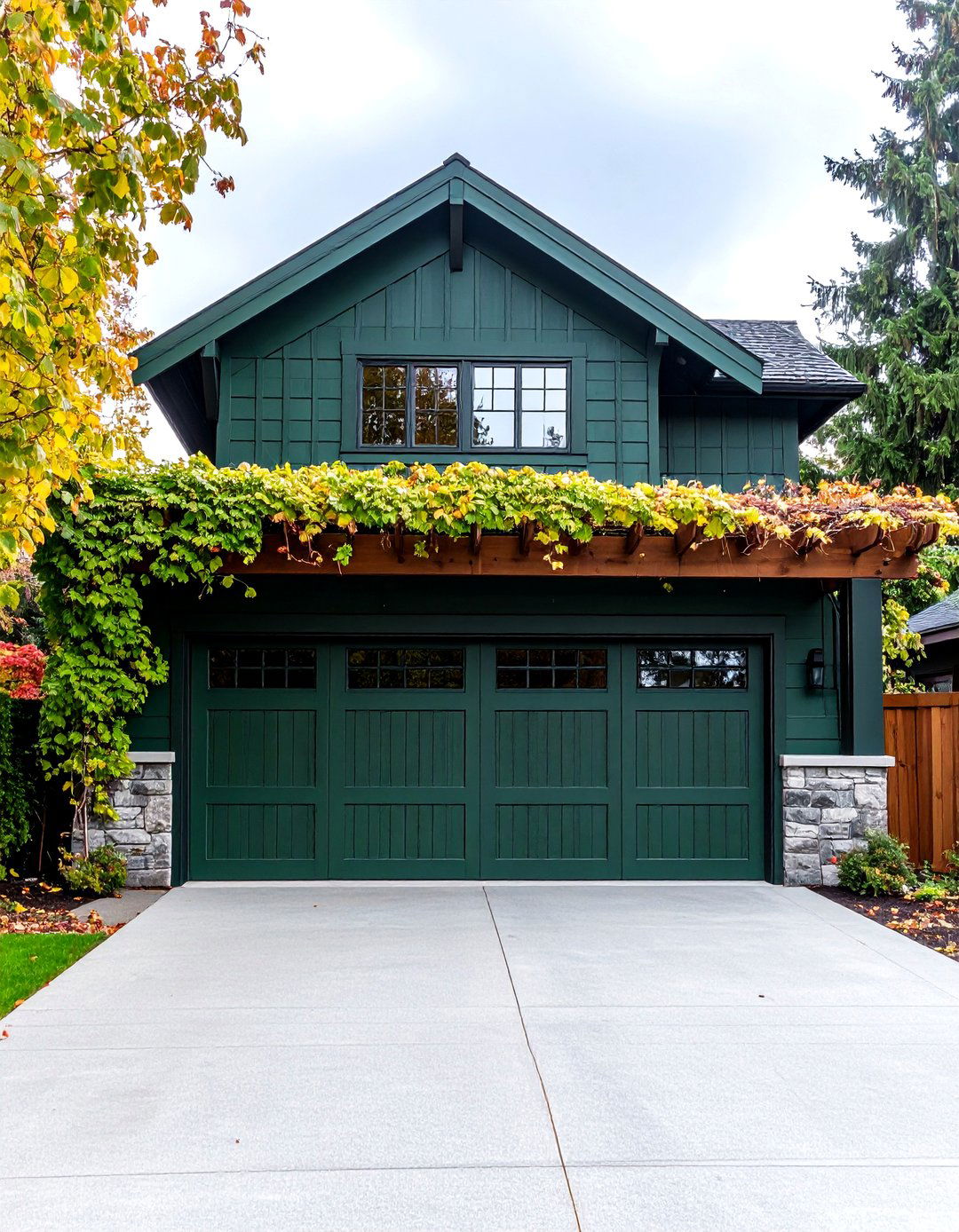
To ease neighborhood concerns about oversized workshops or ADUs, garages finished in a deep dark green exterior recede visually behind the primary residence, especially when paired with a vegetated trellis or vine-covered pergola at the entrance. Install low-profile black roll-up doors instead of white panels; they create one continuous field, minimizing perceived bulk. Where zoning permits, swap part of the wall for slatted wood screening stained walnut; the alternating shadow bands blur edges and promote airflow around stored equipment. Motion-activated, downlight-only fixtures maintain security without spotlighting the structure, letting the landscape dominate sight lines after dusk.
20. Timeless Dark Green Exterior with Neutral Front Door
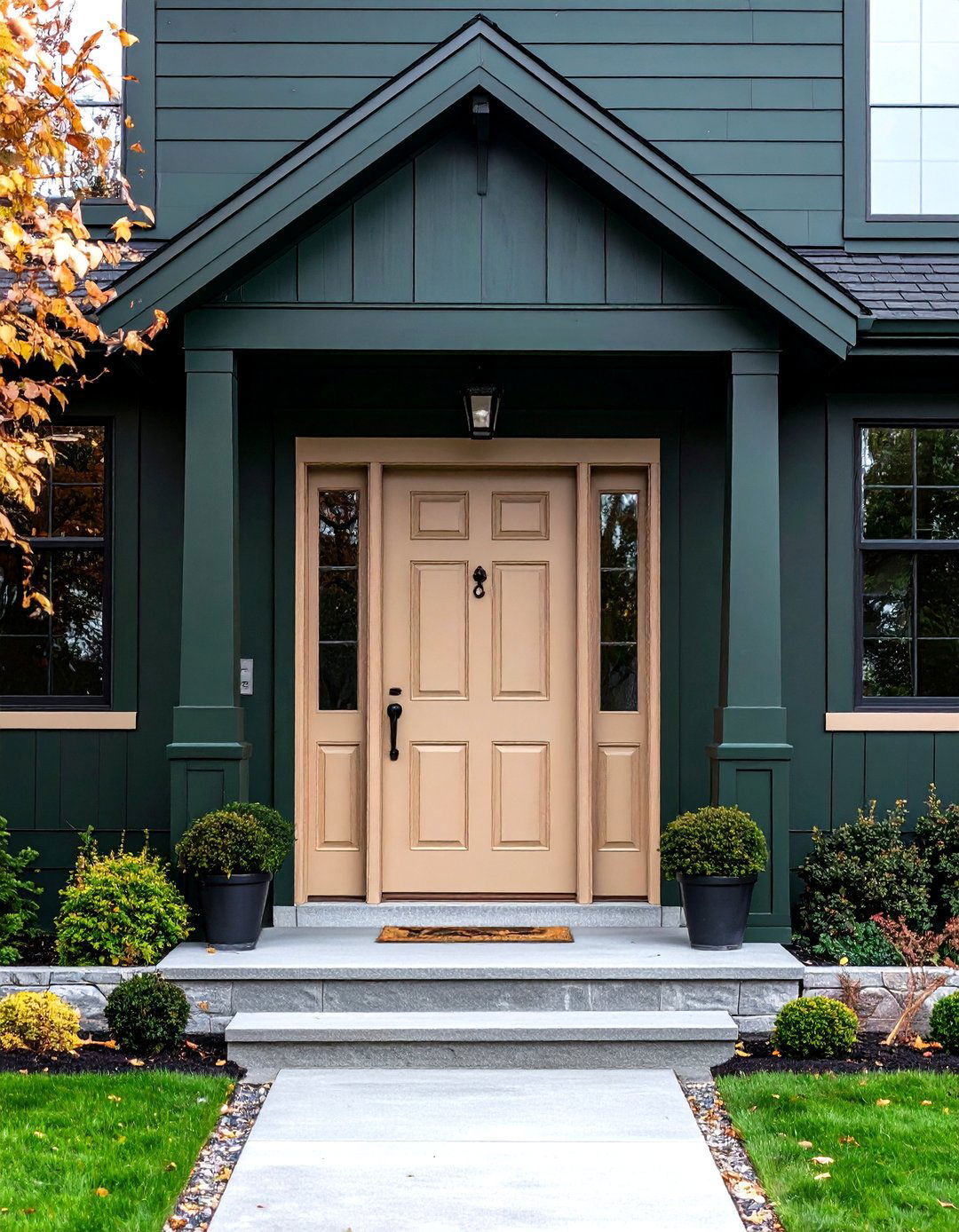
Finally, future-proof your curb appeal by marrying a dark green exterior with a neutral greige or soft taupe front door—tones paint professionals champion as “new neutrals” capable of shifting with interior trends without repainting the whole house. The restrained accent tempers the depth of the walls, making seasonal wreaths and planters pop regardless of color family. Upgrading door hardware to brushed brass adds subtle warmth and ties into current metallic trends without committing to the bolder shine of polished chrome. The result is a balanced palette that endures style cycles and eases future resale thanks to its broad, sophisticated appeal.
Conclusion:
Dark green exteriors offer far more than a vogue color choice—they fuse timeless aesthetics with environmental performance, psychological calm, and pragmatic upkeep. Whether you’re mixing cedar with olive, pairing forest tones with black trim, or capping walls with verdigris copper, each idea above shows how a single hue can adapt to any architecture, climate, and budget while boosting energy efficiency and curb appeal. Select the concept that aligns with your home’s setting, confirm local paint formulations, and embrace the layered richness that only a deep, natural green can supply for years to come.


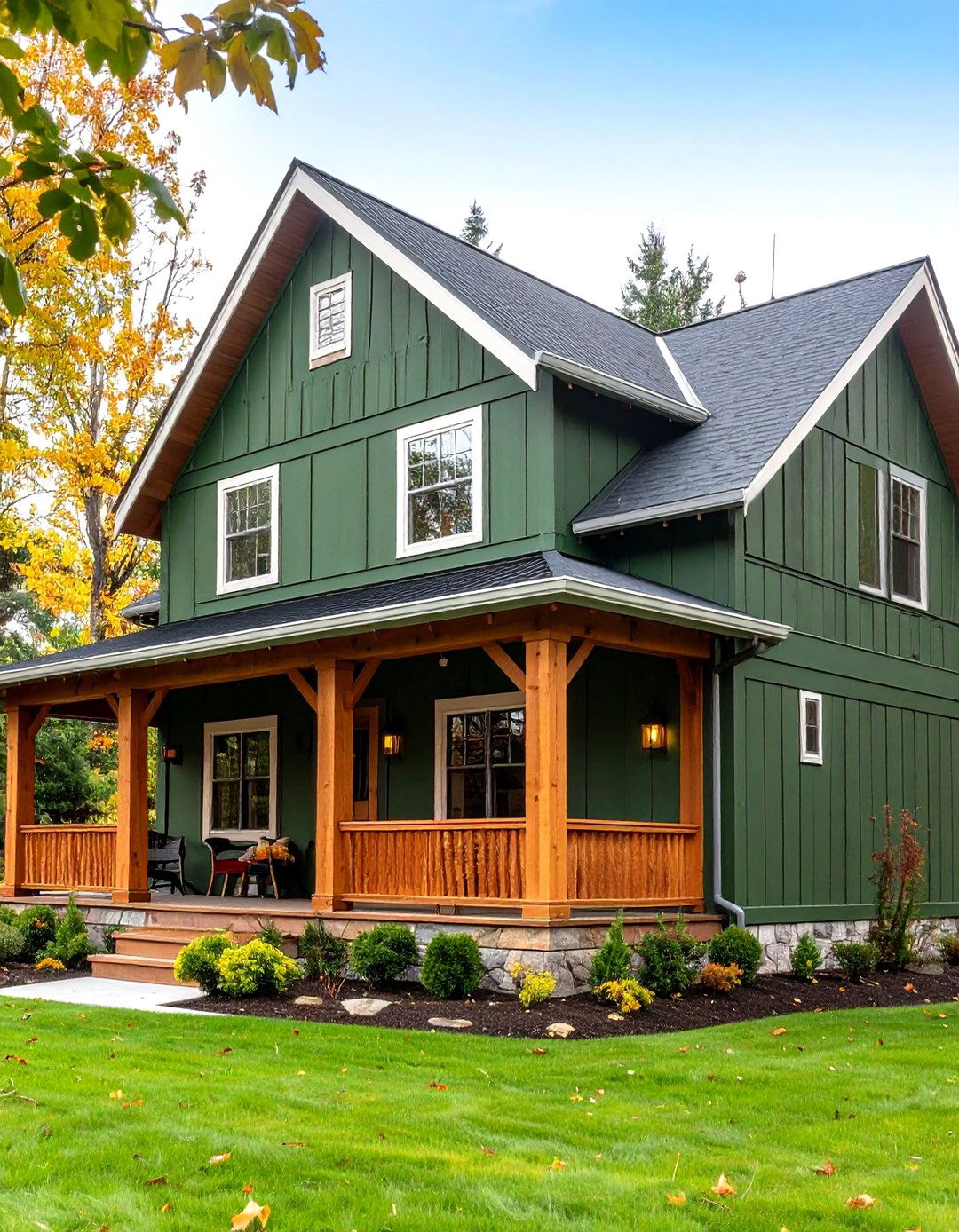
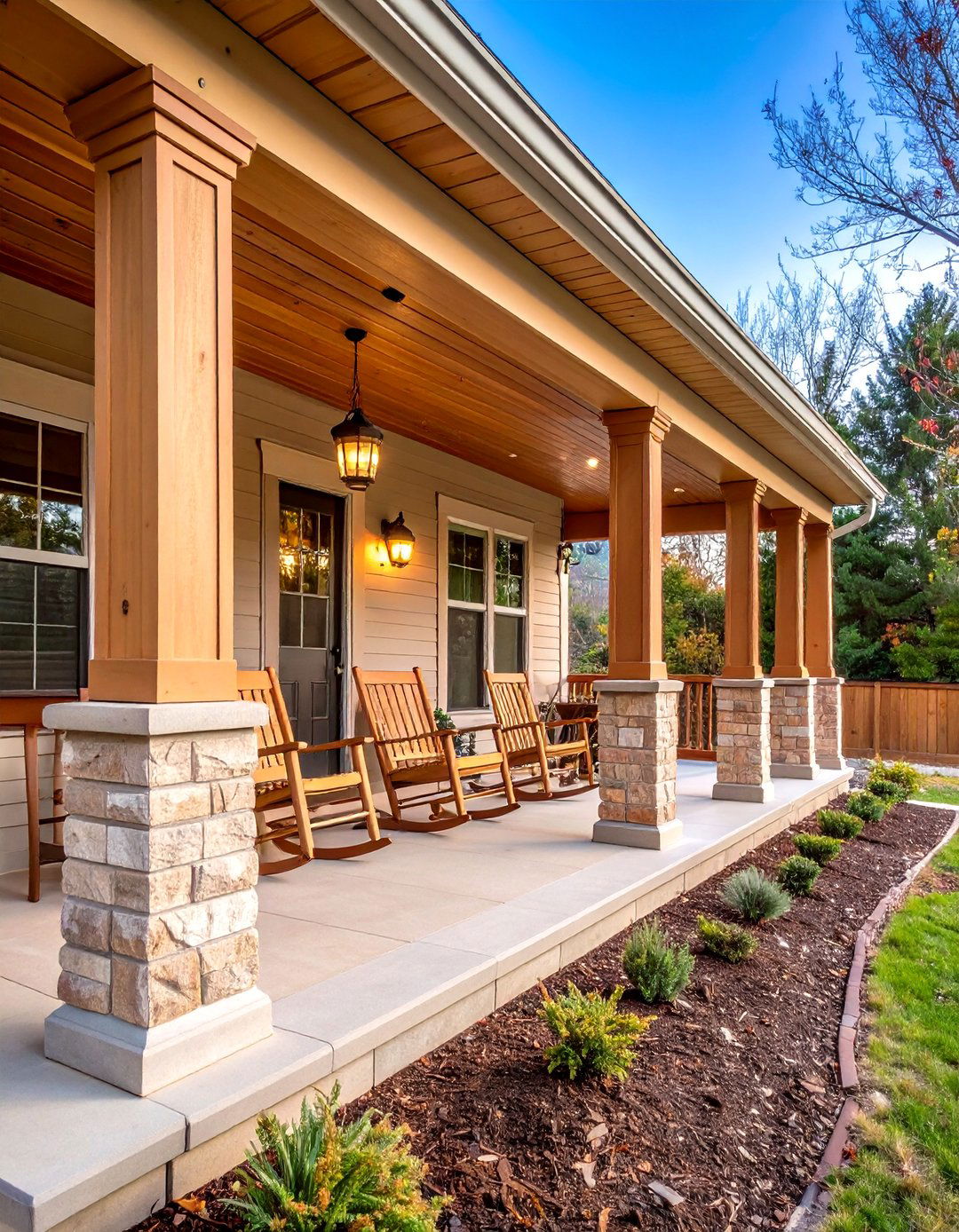
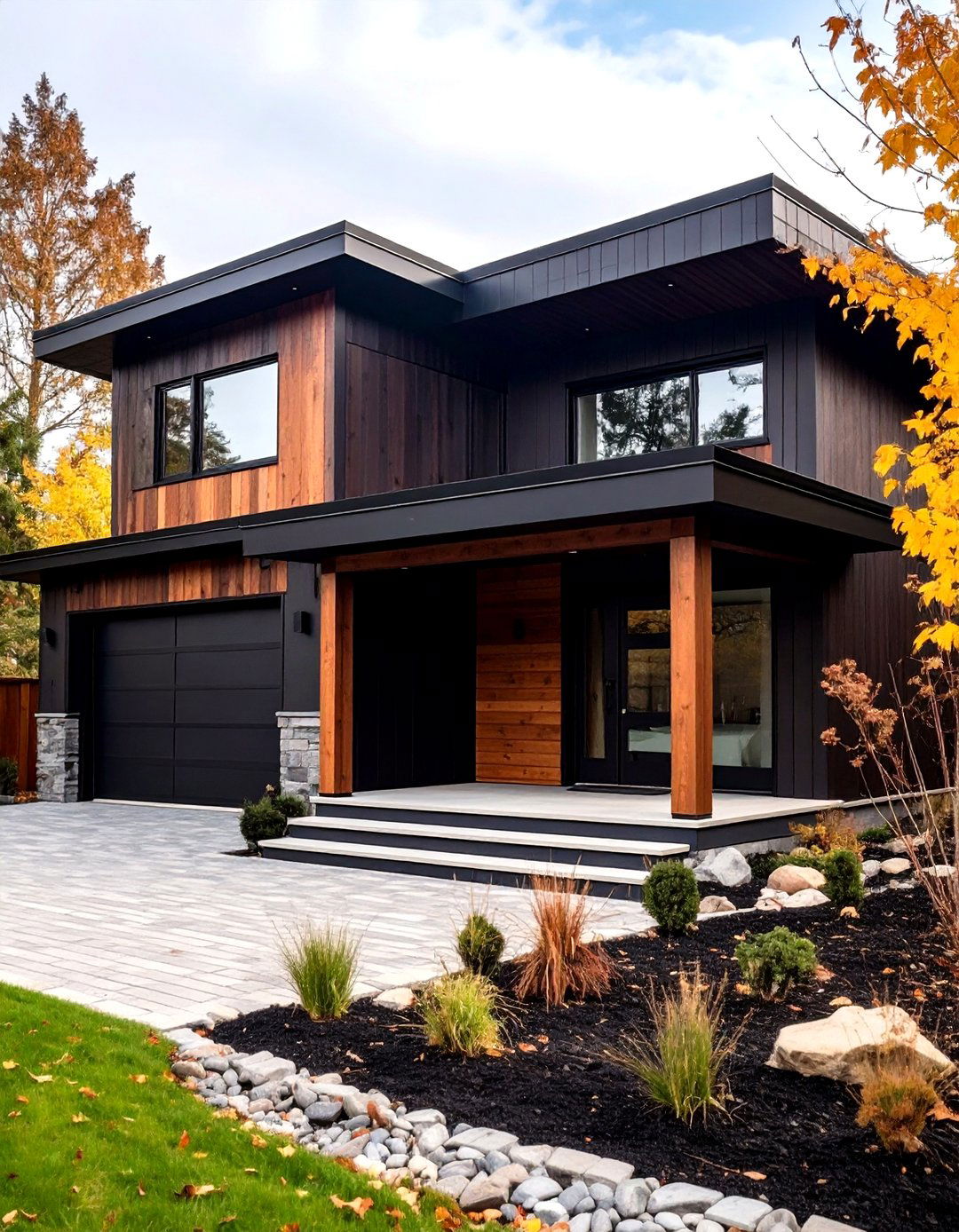
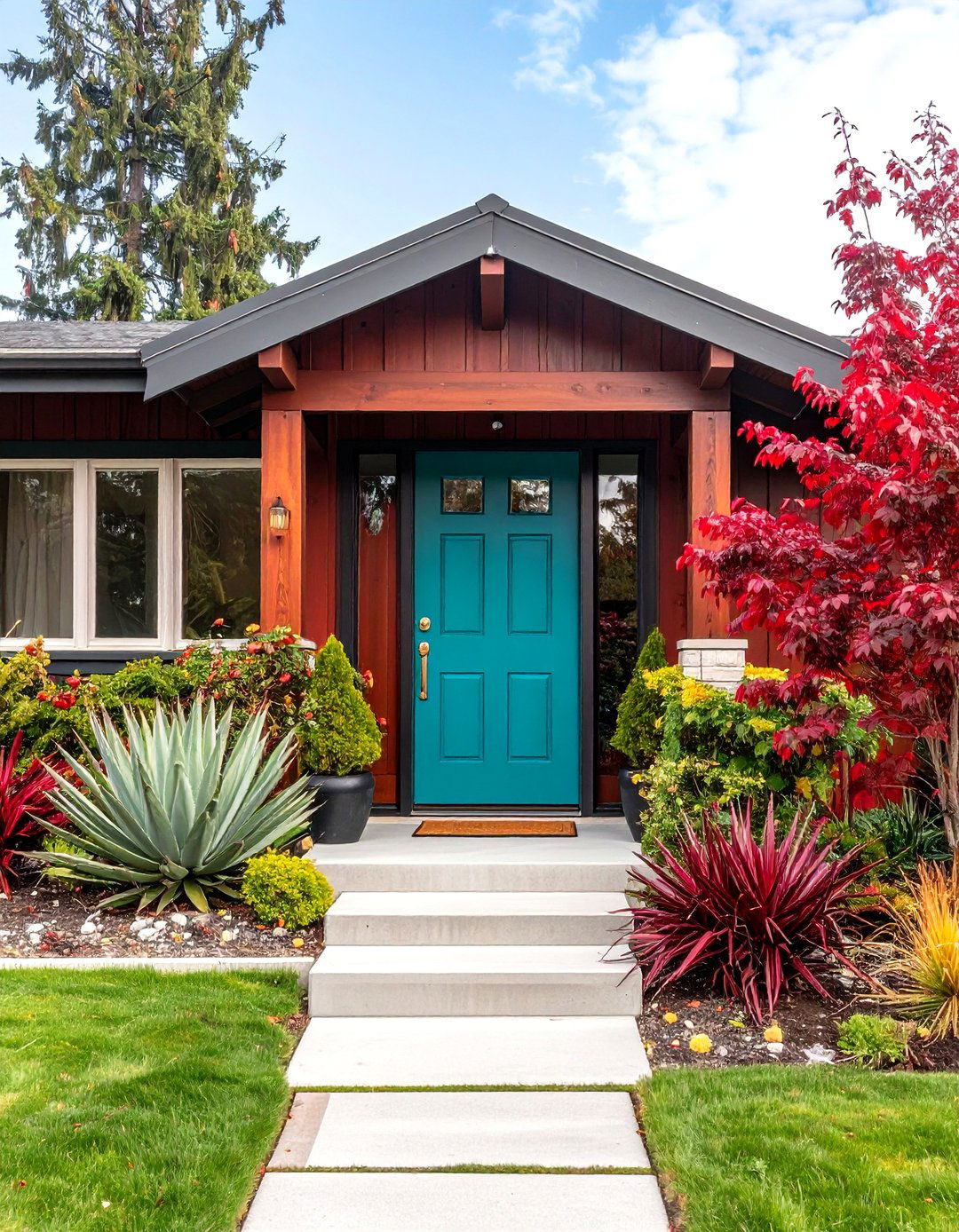
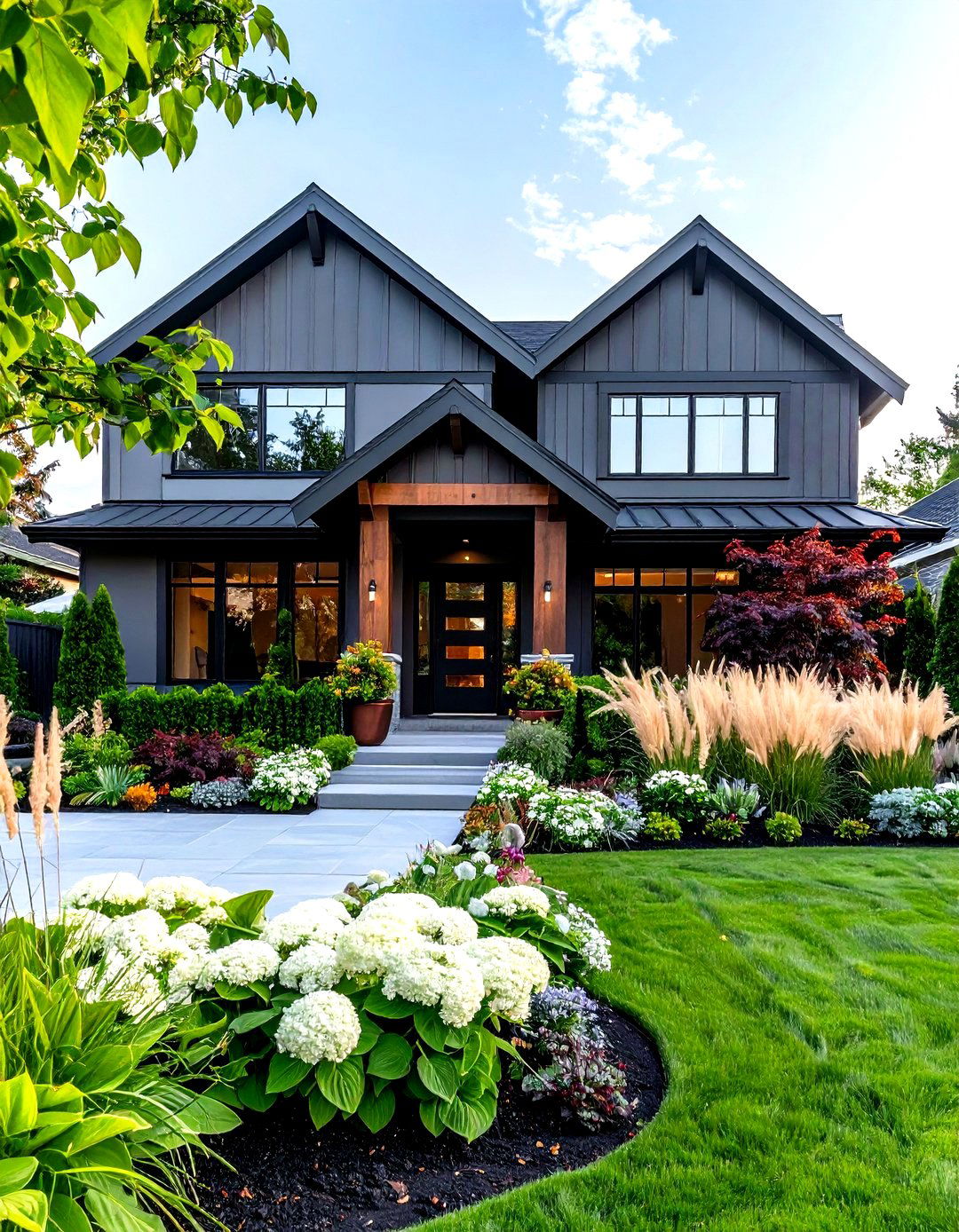
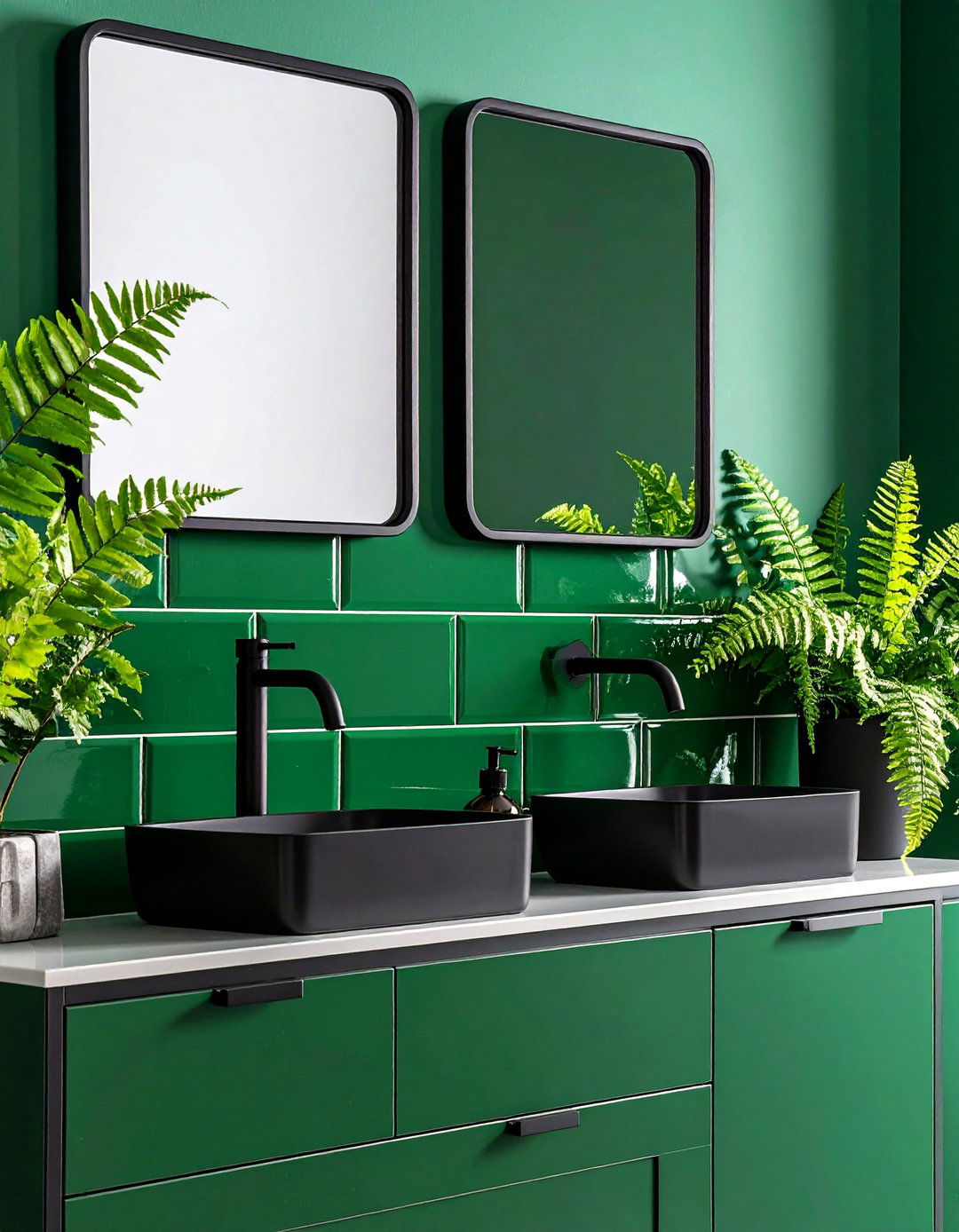
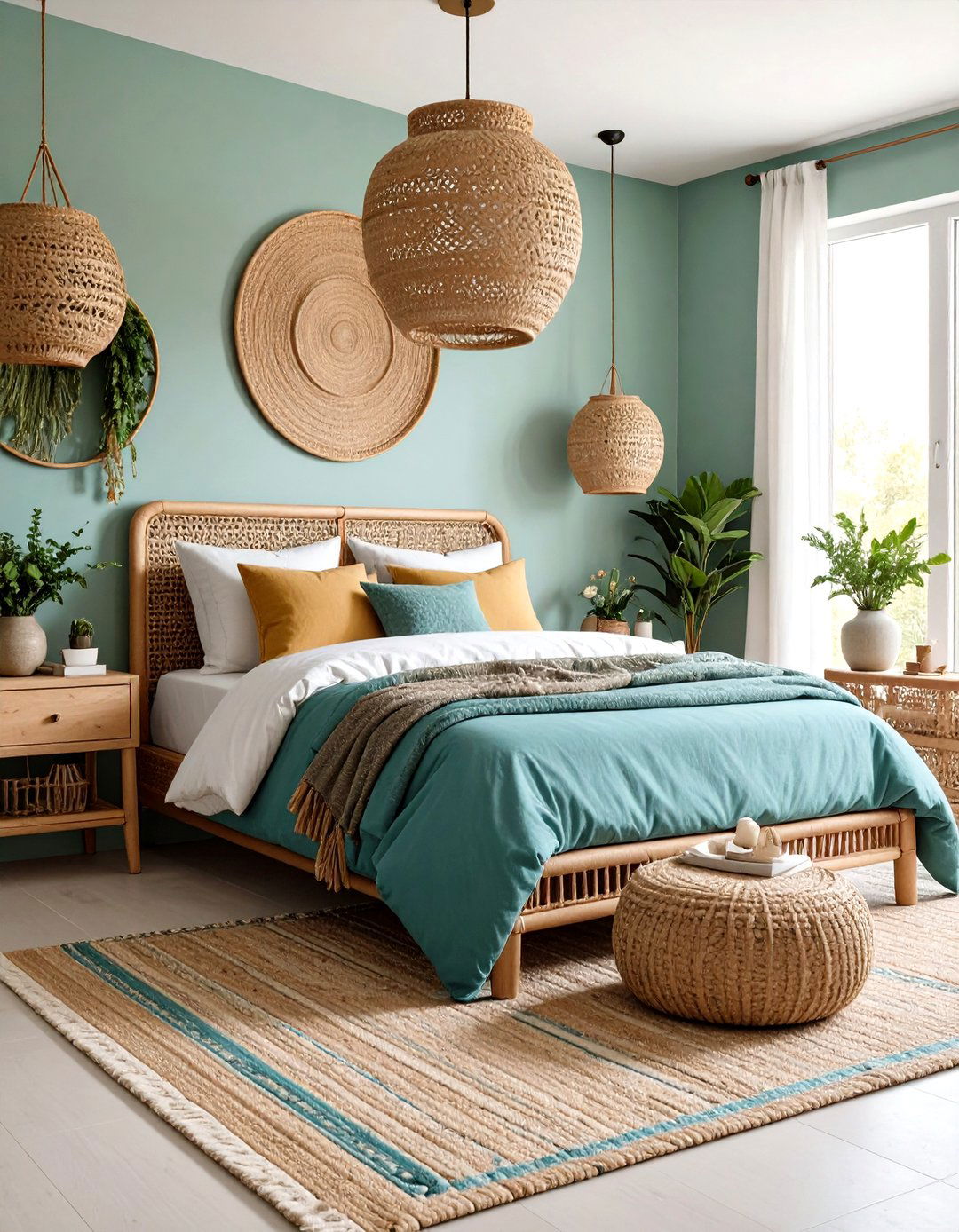
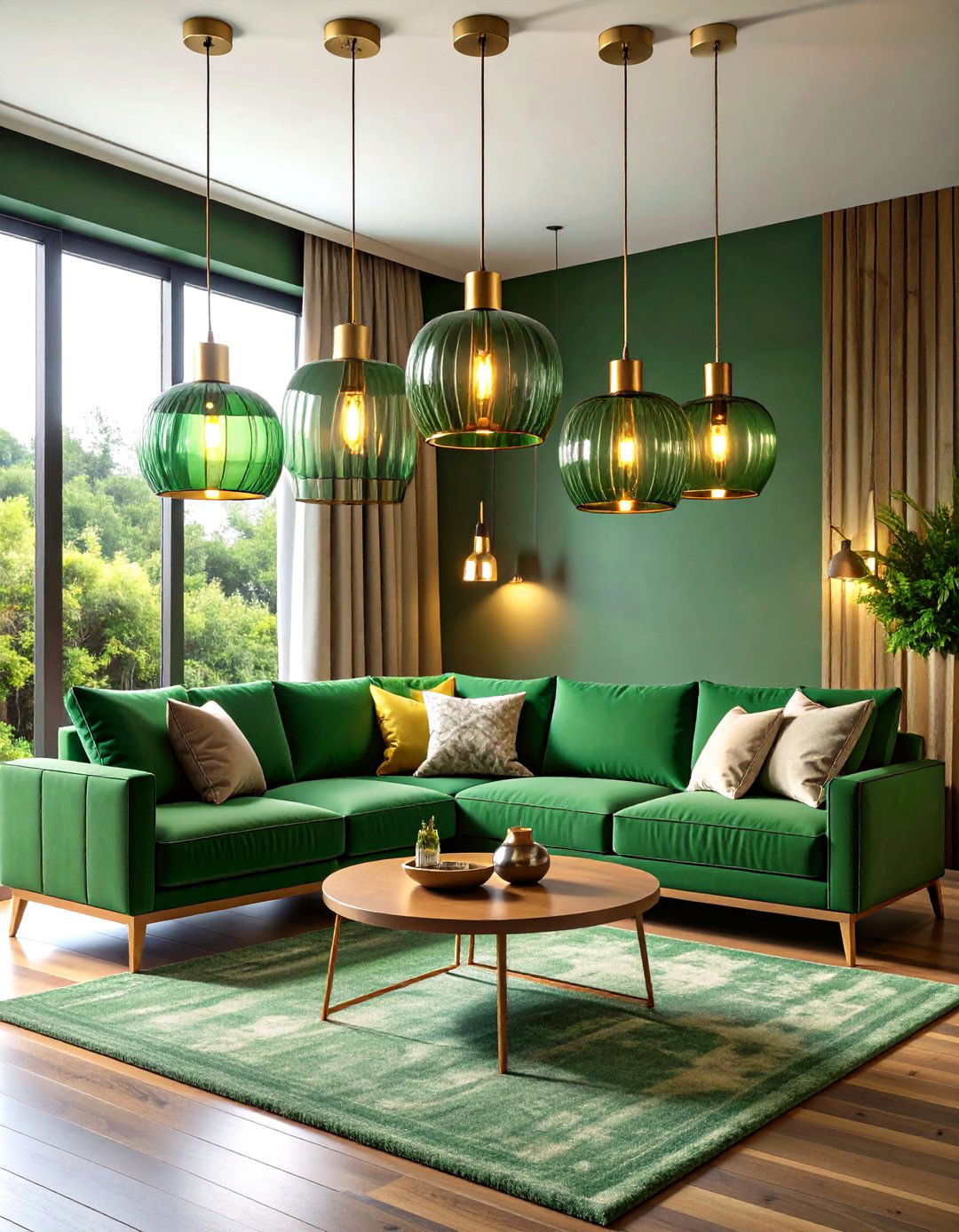
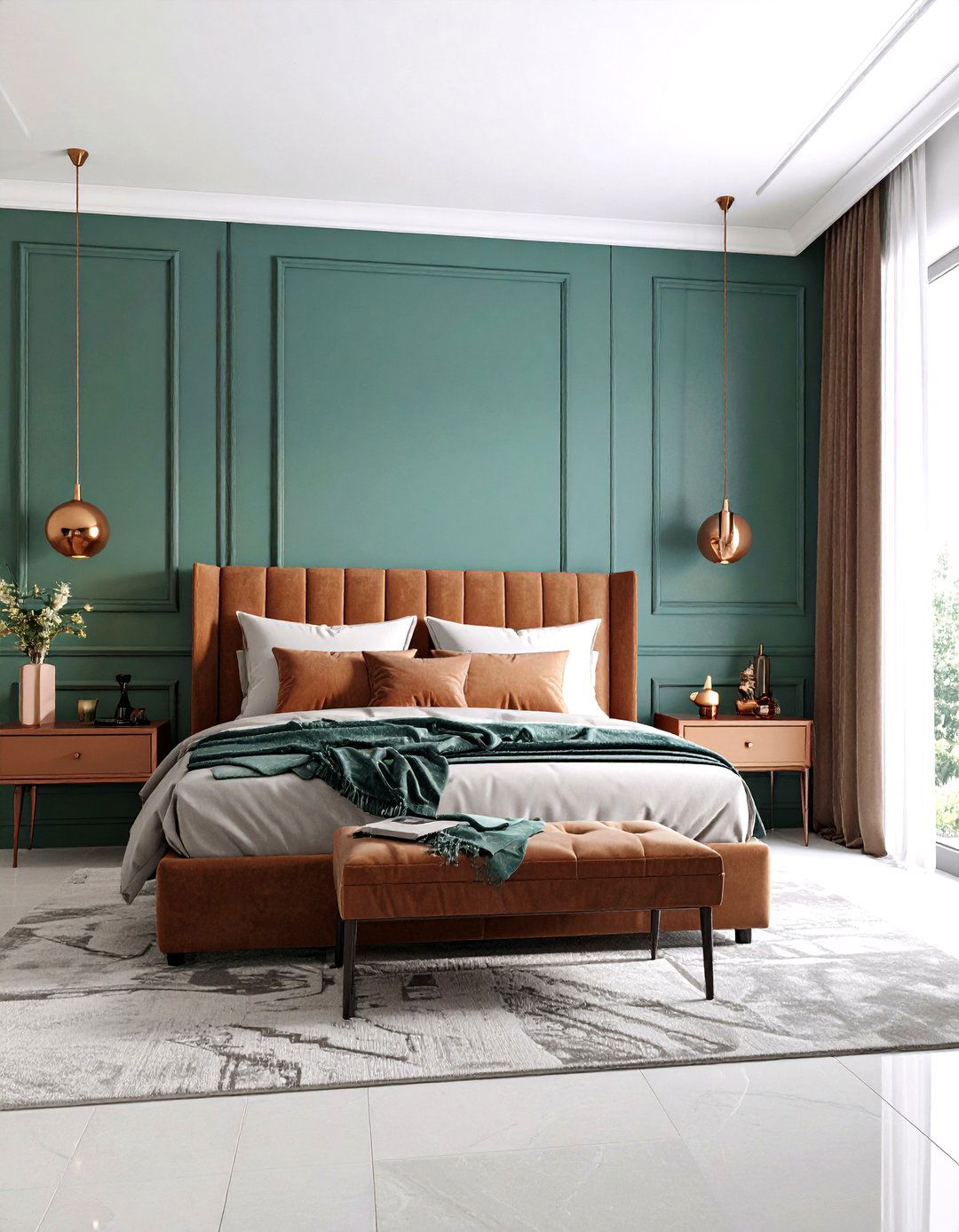
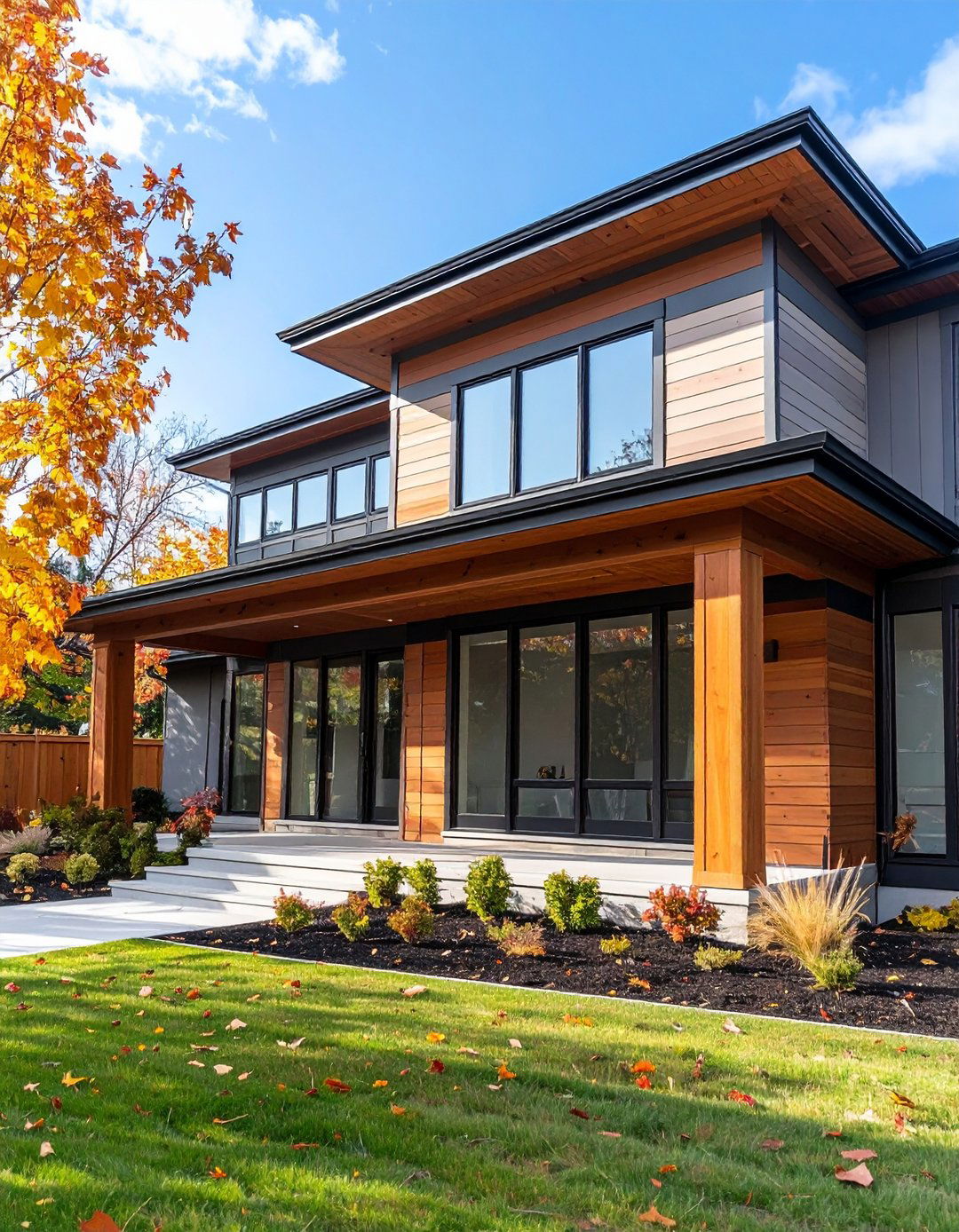
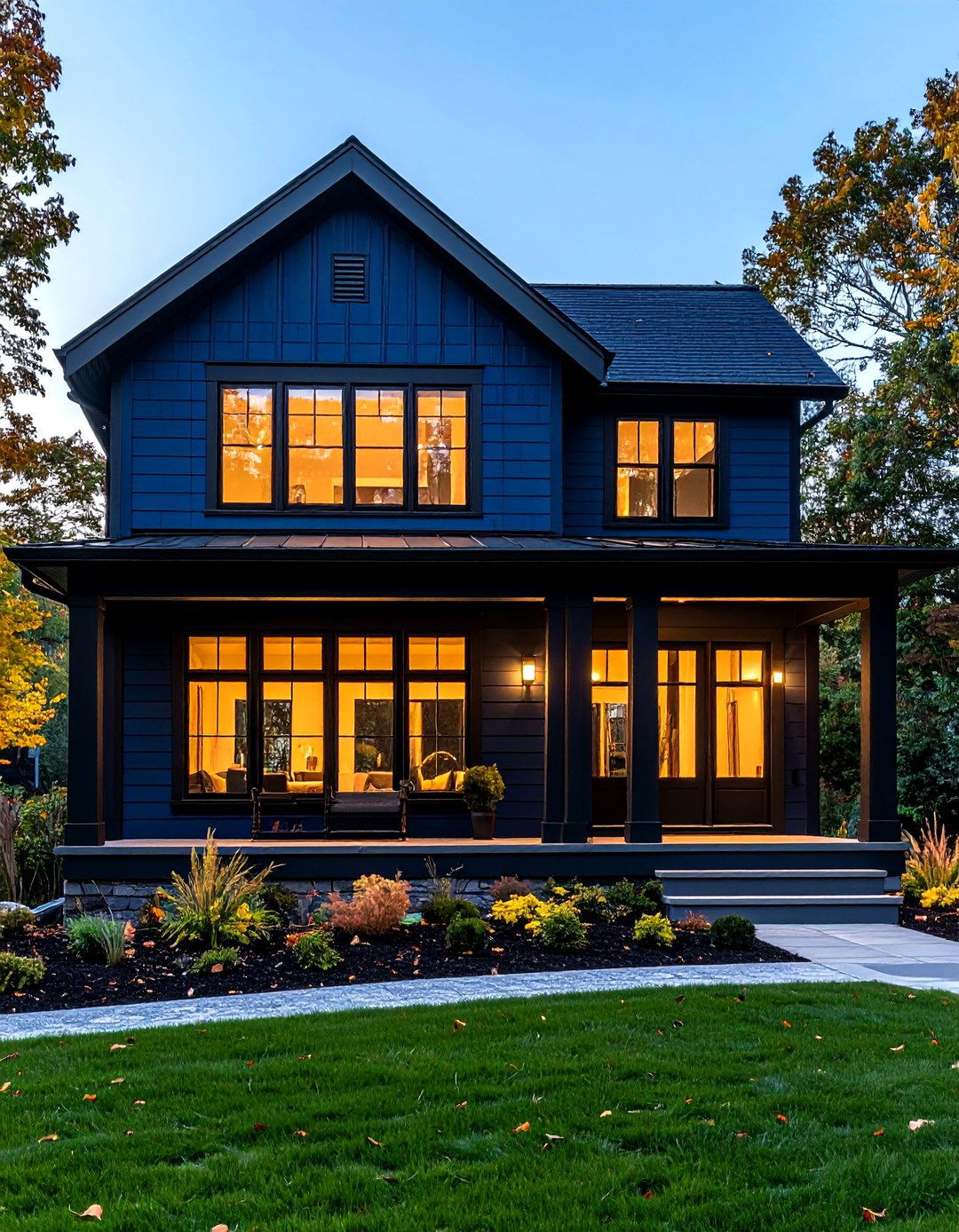

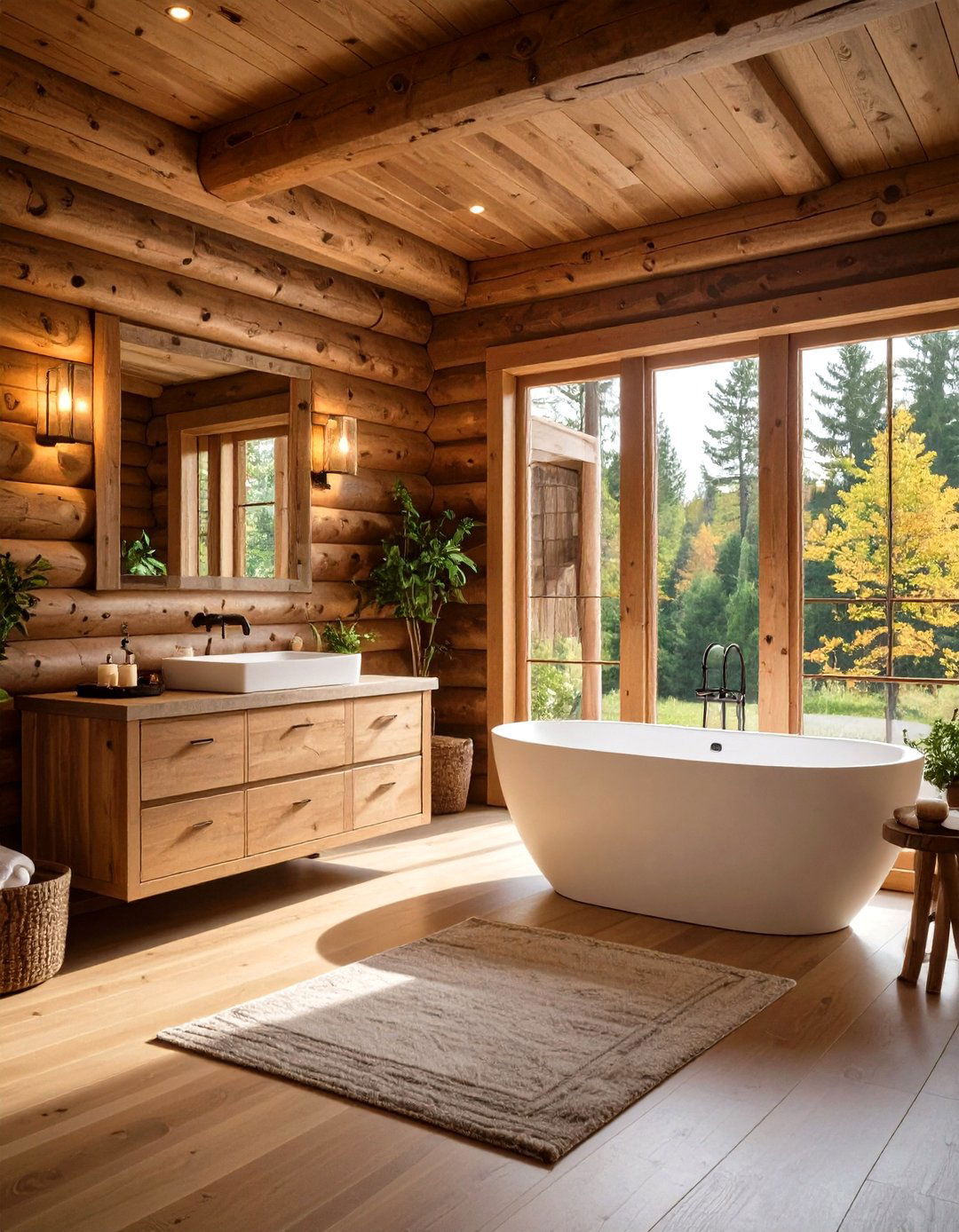
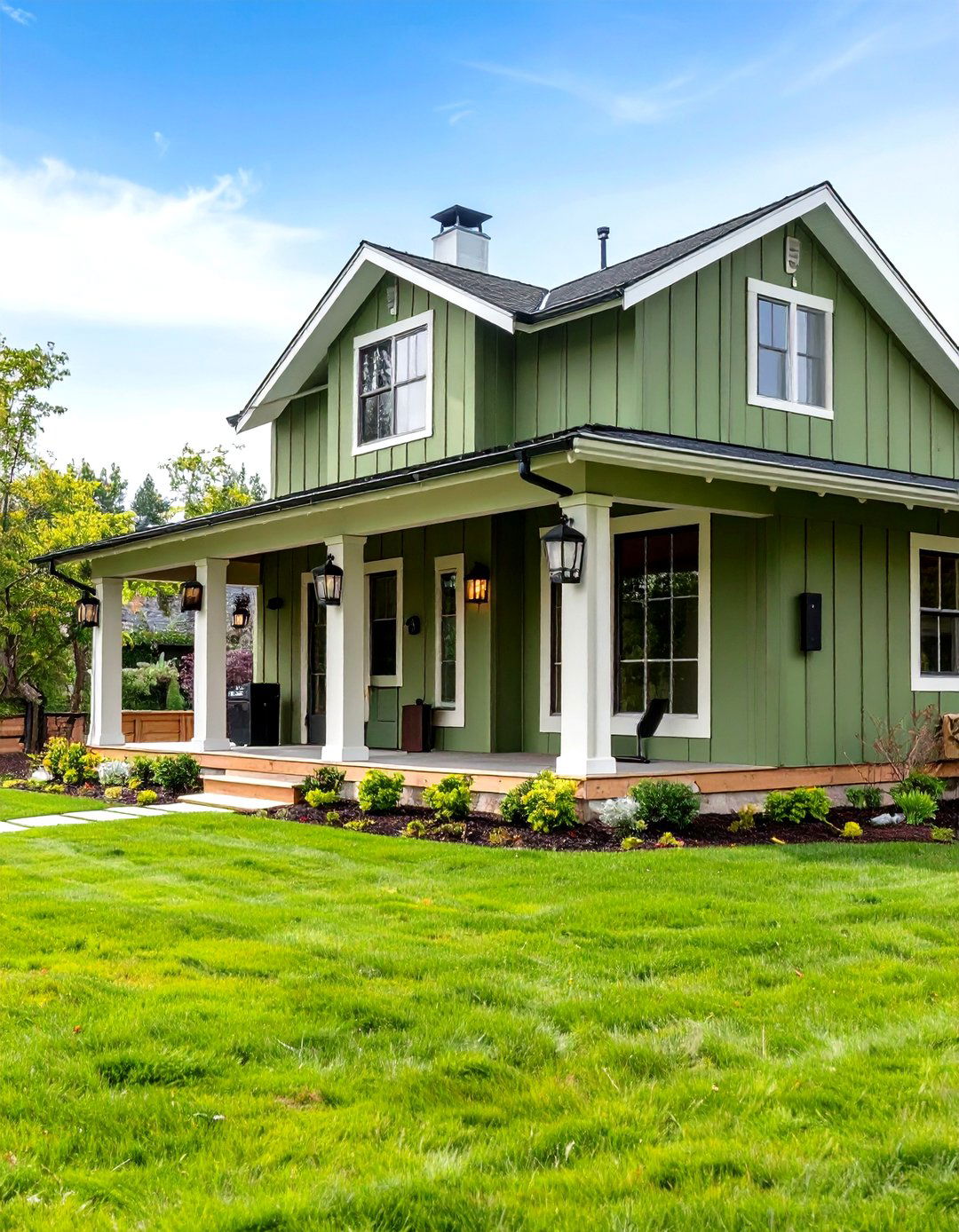

Leave a Reply